












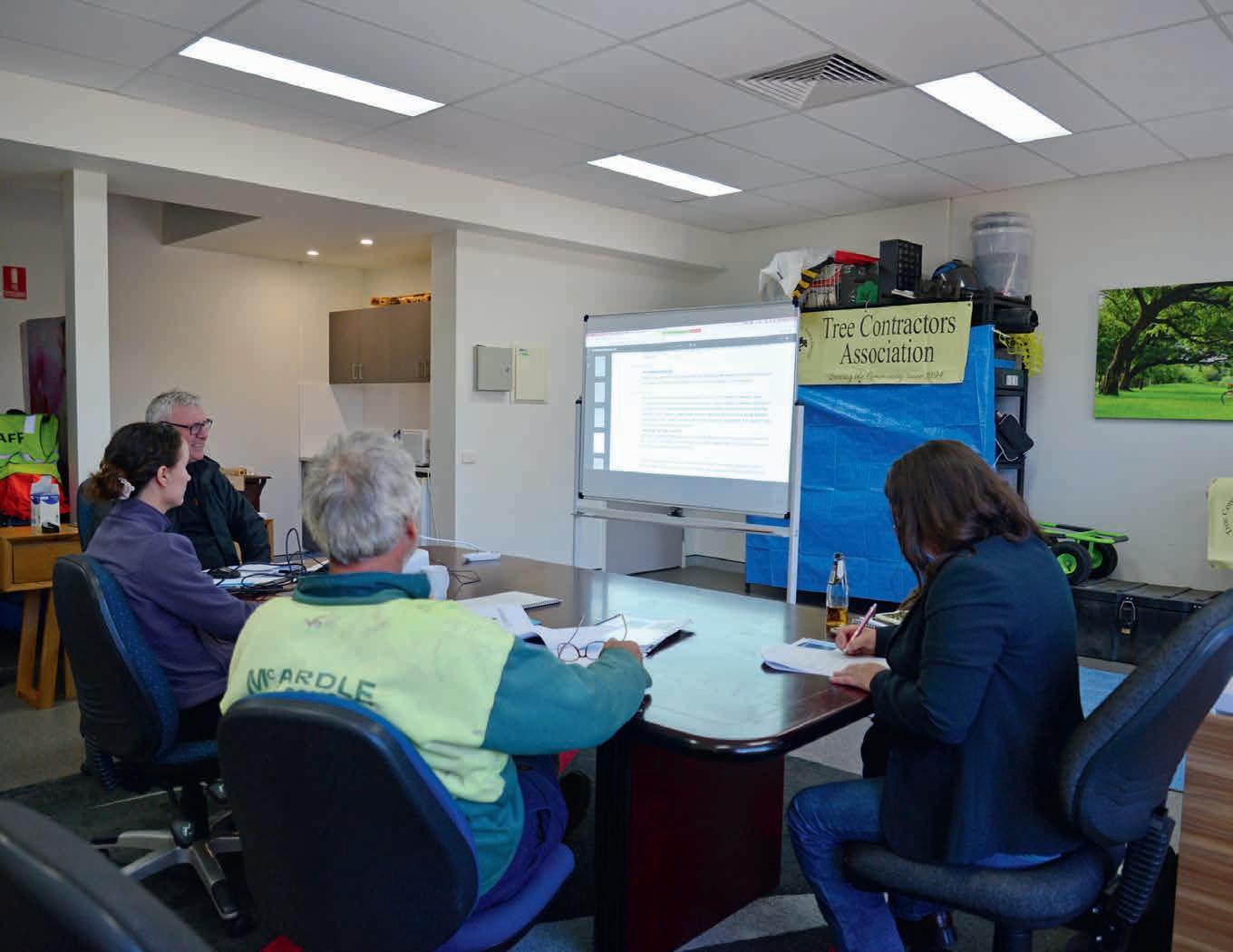
The Australian Arbor Age magazine has been around for a while.
It’s no small thing for any business to be able to claim 28 years of continuous operation, and in the magazine publishing world it’s an outstanding achievement worthy of recognition.
But I had to adjust my perspective of this milestone when, for last issue, I sat with Jim McArdle of the Tree Contractors Association Australia and he ran through a few thoughts on how he’d like to mark the association’s 30th anniversary.
I’ve been around The Australian Arbor Age for a decade or so, writing bits and pieces here and there, and I was pretty happy when the new owners offered me the chance to work on the title full time. I reckoned it was fair to say I had some history with this mag.
But when I sat with Jim and started looking through the material he’d collected, my thoughts on what qualified as ‘history’ were very quickly reassessed.
Jim and his family have been involved in the timber industry and the arbor world across generations – long before the TCAA was even thought of – and Jim’s stories of boiling the billy to have morning tea ready for the crews working in the family timber yard when he was a youngster were a delight to me. His reminiscences of favourite chainsaws and equipment, humorous and colourful timber workers across the years, and some of the unlikely situations which confronted he and his brother during a day’s work made the short time we spent in discussion fly by all too quickly.
And most of that riveting storytelling covered his life with timber before the TCAA came into being.
My time with this magazine has been, by comparison, a very short chapter in a long and ongoing story.
A very great deal of Jim’s wealth of memories won’t make it into the pages of AAA unfortunately, but we’ve seen
some already, and I recommend to you the TCAA pages of last issue if you didn’t have a chance to read them. There’s a huge story between the lines of the short narrative relating the founding of the association and thoughts of past presidents and board members. The achievements of these people were, if anything, understated.
Jim’s a good bloke and we enjoy sharing a coffee and a yarn, and I hope he can be persuaded to share more of his past. We should all hope people like Jim, his family, and the TCAA – now the TCAAA – continue striving to improve the safety and professionalism of arboriculture.
Maybe you have a good story or two to tell from life in the trees?
Arbor Age would love to hear it, and would be very keen to help you share the story with its readers.
Shoot me an email and we’ll see what we can do: Tom.foster@ primecreative.com.au.

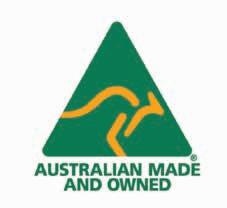

www.piranhachippers.com.au

CEO
John Murphy
COO
Christine Clancy
Sales Director
Bradley Buchanan
Editor
Tom Foster
tom.foster@primecreative.com.au
National Advertising Manager
Arron Reed arron.reed@primecreative.com.au
Phone: 0466 923 194
Client Success Manager
Arianna Lucini arianna.lucini@primecreative.com.au
Design
Cat Zappia
Subscriptions
P. +61 3 9690 8766 subscriptions@primecreative.com.au
Website arborage.com.au The

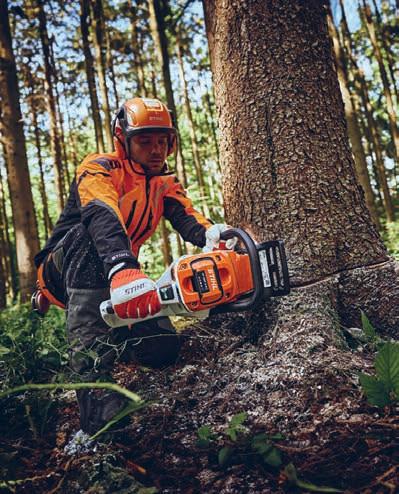


and tree impact assessments.

A professional consulting arborist at Treeswest Australia, certified to AQF level 5 (Diploma), international coach, speaker and presenter.
Believed to be 1500 years old, The Prison Tree – in the language of the indigenous people, ‘Kunumudj’ – has a history nearly as striking as its appearance.
Boasting a circumference of over 14 metres, the historically significant Adansonia gregorii sits just off the Derby Highway in Western Australia, about seven kilometres from the port of Derby itself.
The Baobab is a culturally significant site for the local Nyikina and Warrwa people, and figures in the history of the early settlement of Derby and the region’s pastoral industry. Stories from the early 1900s indicate the tree had
been in use by local Aboriginal people as either a resting or sacred place. Along with the nearby Myalls Bore, the tree was also the last overnight stop for local pastoralists droving cattle to the nearby port at Derby.
The Prison Tree is also said to have been used as a holding area for Aboriginal prisoners being transported long distances to the Derby gaol, and is now a registered Aboriginal site and on the WA State Heritage Register.
With a circumference of over 14 metres, the Adansonia gregorii is a registered Aboriginal site and on the WA State Heritage Register. Image: tolly65/Stock.adobe.com



On the cover

The MC-300 C-O battery-powered chainsaw makes light work of felling and cross cutting large trees. Images: STIHL
With the change in the weather and the end of the financial year fast approaching it’s time for eligible businesses and professionals to supercharge their kit and take advantage of a potential small-business tax break.
The STIHL range boasts a number of professional-grade battery-powered outdoor power tools to help commercial users complete their work safely and efficiently, no matter what the task. And for a limited time, commercial users can get two free professionalgrade batteries with selected STIHL battery tool bundles.
Here are STIHL’s top battery-powered tools for arborists and forestry professionals this Autumn.
Designed with professional users and arborists in mind, the new MSA 300 C-O sets a new benchmark in performance as the most powerful battery chainsaw in STIHL’s growing battery range, making light work of felling and cross-cutting large trees.
The power behind the MSA 300 C-O is the AP 500 S, which was designed
specifically to power the MSA 300 C-O. It’s the first battery in the AP System to use laminated battery cells capable of delivering an impressive highpower output of 3kW – comparable in performance to STIHL’s popular MS 261 C-M, one of STIHL’s all-rounder petrol chainsaws.
The MSA 300 C-O is the first batterypowered chainsaw to feature a full antivibration system, making it extremely comfortable to use. It has the lowest vibration figures across all STIHL’s battery and petrol-powered rear-handle chainsaws.
Launching in Autumn 2024 is the MSA 220 TC-O, STIHL’s high-powered battery top-handle chainsaw, designed specifically for trained professionals, which now features an oil sensor on an LED display. This innovative new added feature gives the user a warning when the chain-oil level is low.
With a compact and well-balanced design, the MSA 220 TC-O is easy to handle in awkward or outstretched positions. The intuitive trigger lockout system is simple to use, and the electronic unlock button is within easy reach of the thumb. The status LED will light up green when the chainsaw is ready for use, and the chain brake LED will light up red when the chain brake is engaged, so the operator can easily see when the tool is good to go.
Paired with the AP 300 S battery and the NEW 3/8 PS3 Pro chain, the MSA 220 TC-O’s output is comparable to that of STIHL’s popular petrol-powered MS 201 TC-M.
With a compact and well-balanced design, the MSA 220 TC-O is easy to handle in awkward or outstretched positions

Paired with the AP 300 S battery and the 3/8 PS3 Pro chain, the MSA 220 TC-0’s output is comparable to that of STIHL’s petrol-powered MS 201 TC-M.
On the cover

Get two free pro batteries with selected AP battery system tool bundles “ ”
The particularly rigid telescopic shaft for the HTA 135 enables quick length adjustment and exact positioning.

The HTA 135 battery powered pole pruner is the most powerful battery pole pruner in the AP Battery System. Reaching up to five metres in height, the HTA 135 allows professionals to complete their work safely from the ground rather than climbing the tree, saving plenty of time and reducing the risk of injury. The lightweight magnesium gearhead helps with maneuverability and balance, while the tough branch hook helps with the removal of loose cuttings from the tree itself.
The particularly rigid telescopic shaft of the HTA 135 enables quick length adjustment and exact positioning. allowing precise cutting of tall trees. The telescopic shaft can be extended up to a length of 405cm, with the total length of the tool ranging from 285cm to 405cm.
The HTA 135 allows professionals to reach a height of around five metres and can be used with 3/8"P and 1/4"P STIHL saw chains, ensuring maximum cutting performance.
The STIHL AL 301-4 is a gamechanger for professionals utilising STIHL’s commercial range of battery powered tools.
This mobile multi-battery charger allows professionals to charge up to four STIHL AP or AR batteries sequentially, meaning they’ll never be without a fully charged battery throughout their day.
The AL 301-4 is specifically designed for use in vehicles and on the go, therefore has a robust design as a result. The AL 301-4 is compatible with all AP batteries, and is also capable of charging STIHL’s AR backpack batteries with a connecting cable and STIHL AP adapter.
Charge through autumn with battery power by STIHL. For a limited time, get two free pro batteries with selected AP battery system tool bundles.
Visit your local STIHL dealer to learn more today. Find yours at stihldealers.com.au.
The HTA 135 battery-powered pole pruner is the most powerful pole pruner in the AP Battery System

100-per-cent Australian designed and made, Piranha chippers offer impressive performance. Images: Piranha Woodchippers

A brand new, Australian-designed and made commercial Woodchipper will be launched at The National Diesel Dirt and Turf Expo in April.
Piranha chippers are the latest kids on the block – a brand new commercial Woodchipper manufacturer focused on delivering world-class machinery.
100-per-cent Australian designed and made, Piranha chippers offer impressive performance and productivity capacities and are fully backed by an industryleading five-year structural warranty.
Built on 30 years of wood-chipper passion and design obsession – including three generations of timber-industry experience – Piranha is bringing a different approach to operator experience and work-site efficiencies. Piranha chippers continually give highperformance and yield the highest return-on-investment figures, ultimately increasing bottom-line dollars.
Starting with the best Piranha’s suppliers are top of the line in their businesses – the best brand names,

A brand new commercial Woodchipper manufacturer focused on delivering world-class machinery.
proven in their fields and supported locally.
Australia is renowned on the world stage for cutting-edge technologies in the aerospace, mining and automotive
industries, and Piranha has tapped into these top engineers and their resources to offer the most productive, efficient and modern woodchippers available on the market today.

Australian-made structural-grade steel is used in all components of Piranha’s chippers.
To ensure the highest quality workmanship Piranha’s professional welder tradespeople are independently tested and NATA certified to AS/NZS 1554.1 welding standards, ensuring Piranha’s peace-of-mind as it stands behind its industry-leading, five-year structural warranty. Australian-made structural-grade steel is used in all components of Piranha’s chippers, ensuring they are world-class and the best of the best.
Some of the leading features that set apart the BT300 Piranha chipper include:
• Twin axle trailer design – supplying double the braking power and twice the flotation over soft surfaces compared to single-axle units
• Load-sharing ‘Soft-Glide’ leaf-spring suspension provides a superior ride compared to a single-axle trailer and doesn’t send violent feedback through the drawbar into the tow vehicle, making towing the Piranha a safe and enjoyable experience, and
• Heavy-duty all-terrain tyres on tough steel rims ensure the BT300 will easily go anywhere the tow vehicle can.
Piranha’s ‘Posi-Arc’ infeed-arm pivot design means the large top infeed wheel aggressively climbs towards the incoming timber, up and on top of the trunks and brush, through the natural positively inclined arc the unique feedarm design provides. This makes for a very strong feeding action, allowing the Piranha to pull in difficult branches, twisty timber and whole trees with ease. The hydraulic lift and crush also aides in feeding difficult timber sections into the chipping drum if branches are particularly crotchety and difficult. The
350mm high x 500mm wide in-feed opening directly into the chipper drum housing ensures the Piranha saves as much time and effort as possible.
The unique staggered four-knife chipper drum – designed in-house by the Piranha team – with integrated high-velocity fans makes for a superior chipping action and a very strong chip discharge. Being 650mm in diameter ensures the chipping/cutting action is only done on the lower half of the circular arc, resulting in less vibration and fuel use. The replaceable blade-bolt blocks ensure the drum does not suffer integrity damage if the blades encounter foreign material fed into the machine and they can be easily replaced if ever required.
The chipper drum access hood completely exposes the top part of the drum when opened, making changing the knives very easy and practical.
All manufactured sheet-metal steel parts are individually primed and painted before assembly for superior, long-lasting corrosion protection,
ensuring the Piranha will continue to look good and perform flawlessly for decades.
Piranha chippers come standard with many features that work together to reduce the operator’s fatigue and stress, including:
• Hydraulic auto clutch
• Hydraulic winch
• Hydraulic tailgate raise and lower
• Hydraulic 360° discharge chute (continuous swivel)
• Twin (top and bottom) horizontal infeed wheels
• Central grease-station hub
• Full-sized spare wheel, and
• Bulletproof one-touch capacitive switches for quick and easy operation of all functions.
They’re all standard on the BT300.
The Piranha team is ready and waiting to answer any questions. Book your demo session today so you can see for yourself how well the BT300 performs.
Call 1300 406 171 or log on to piranhachippers.com.au.

Replaceable blade-bolt blocks ensure the drum does not suffer integrity damage if the blades encounter foreign material.
Hire companies across Australia and New Zealand have long had HANSA in the range, though one machine seems to be a staple – the HANSA C25.
Chippers get a hard time in the hire industry, being used by changing customers, different levels of skill and knowledge, and machines are pushed to their limits and beyond. It needs a strong product to perform under those circumstances.
That’s why hire companies choose HANSA.
“Like many of us, hire companies are businesses where reliability and performance is key to business continuity and success,” said John Lyon at HANSA Products Australia. “Our machines deliver that for them”.
There are some eye-watering stories of the condition in which some chippers have come back in after hire.
“Pasted with sand and salt from chipping mangroves all day,” recounted John. “That machine got a deep clean!”
Luckily for the hire companies mangroves are few and far between, and overall if the customer is inducted

on the machine correctly it should just be a matter of standard-use maintenance – like knife sharpening and a clean before the next hire.
Hansa has been in the hire game since
1996 and works with all the big names, like Kennards and Hirepool, while also providing machines to independent hire companies. The HANSA C25 is the go-to for the hire companies looking





Offering 160mm (six-inch) capacity on a small footprint and powered by the Honda GX690, the HANSA C25 is just the right size for the majority of the hire-market customers.
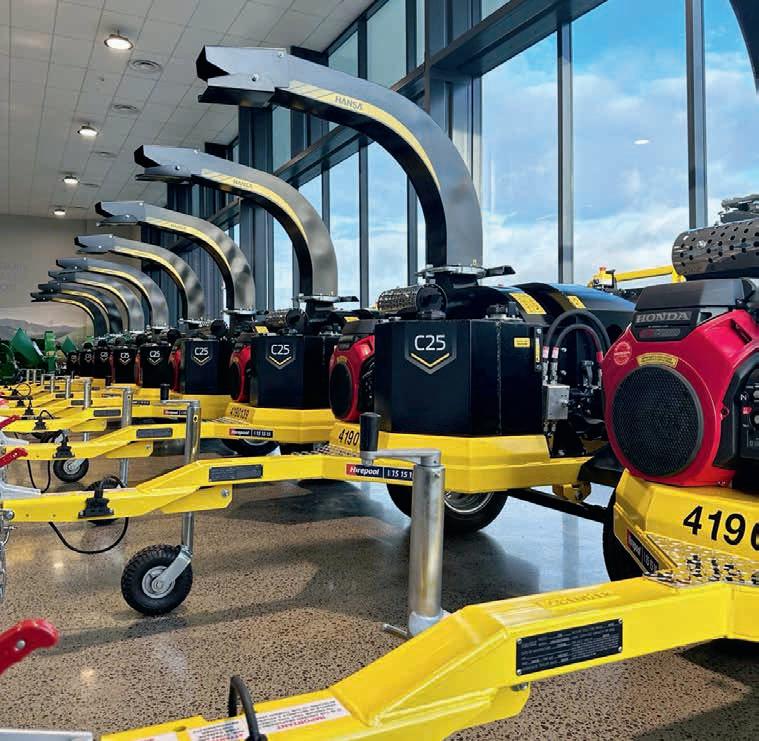
for a hydraulic-feed solution for their customers.
“We have great relationships with our hire customers. We know what they need and go the extra mile to ensure they have it” said Lyon.
HANSA has a bespoke training and onboarding procedure for hire outlets, ensuring when a new machine is despatched the hire team is fully trained and skilled on how to use and induct
customers on the machine.
“Ensuring the hire team is 100 per cent confident and capable is key to keeping the operator safe,” Lyon confirmed. HANSA even has a ‘Return From Hire’ checklist developed over the years with customers. This ensures when a machine is returned after hire, the correct checks and controls are done with the operator. It’s a catch-all system, making sure the machine is not damaged and the correct checks are complete before the next hire.
HANSA has lots of customers who have followed the ‘Hire it. Try it. Buy it’ route.
Purchasing a chipper is a significant investment, and hiring a machine before making the leap is a great way to get a feel for what capacity or type of machine is needed. Using the machine on your worksites, towing it behind various vehicles, using it in various crews and contracts, spending time going over the machine, looking at the service

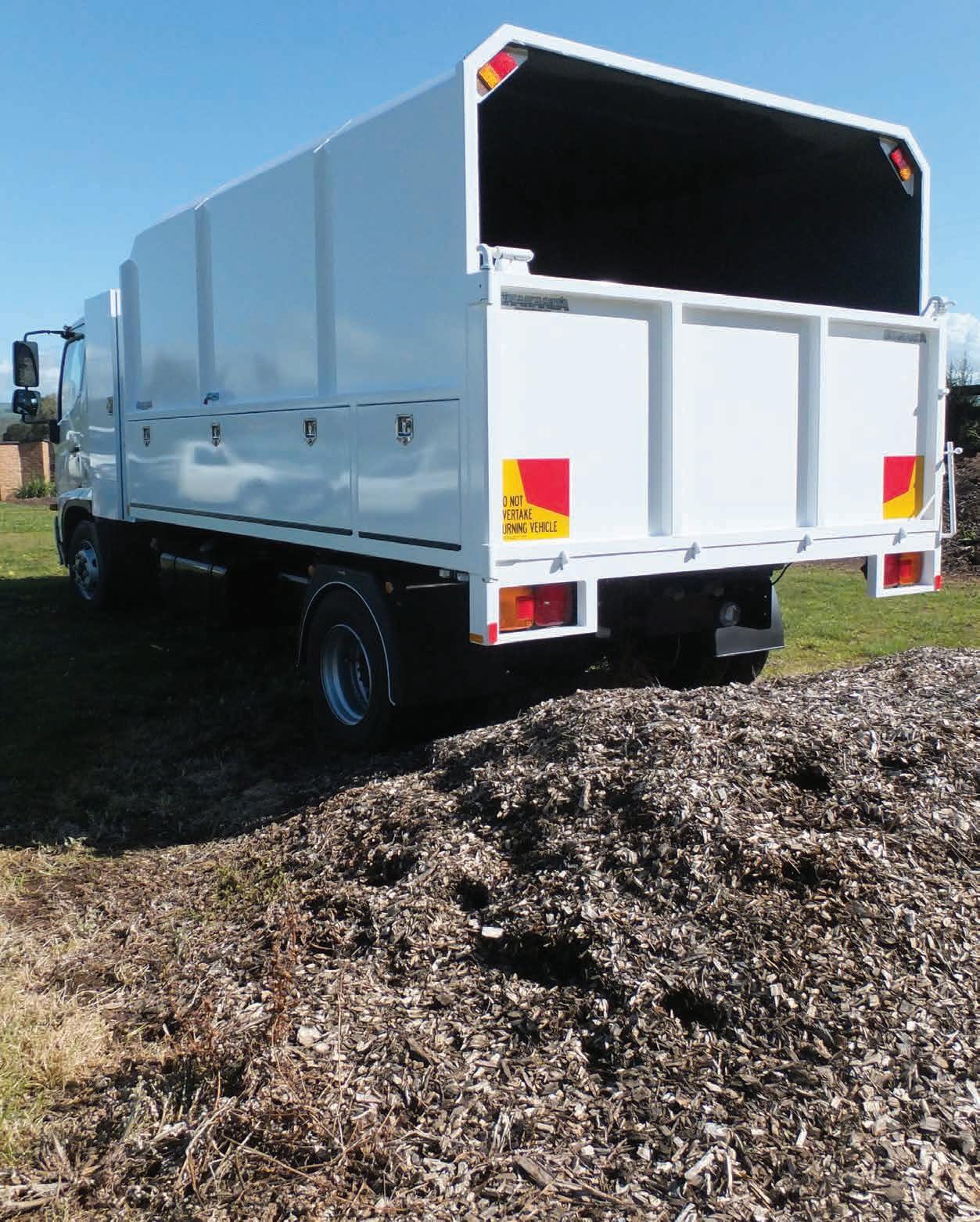

The protective coating system on our chipper bodies means we can comfortably say we would expect no less than a 10 year lifespan from our chipper bodies.
Shakanda Engineering is able to offer a long list of features on its chipper bodies. Customers can have two-way tailgates, barn doors, toolboxes in one or two sides of the body, ladder racks, pole-saw boxes, a variety of towbar options with pintle hooks or combination ball and pintle hooks, change the body size to increase the front toolbox, or change the overall dimensions of the body if they want to alter the capacities for a particular truck.
We pride ourselves on back up service if anything goes wrong. The highest standard of design and quality are built into every one of our projects, backed up with a full Three Year Structural Warranty on all manufactured vehicle bodies.
procedures, maintenance and overall build of the machine in your own time and with your team really helps you make an informed decision.
Offering 160mm (six-inch) capacity on a small footprint and powered by the Honda GX690, the HANSA C25 is just the right size for the majority of the hire-market customers.
Commercial arborists and landscapers, looking to hire a chipper to cover extra work loads or a brokendown chipper, can get the cover they need with this reliable machine. The towing weight of 885kg (fully spec’d) makes it easy to incorporate into a fleet and teams at short notice.
Boasting a powerful 81kg cutting disc, the machine makes good use of its extra wide infeed of 330mm x 178mm.
This extra-large in-feed increases productivity by allowing the operator to feed in larger volumes of branches at one time.
The HANSA soft-start technology is also on the C25.
After starting the machine the operator engages the cutting disc by winding in the engagement handle. This brings the drive-belts under tension, and once fully engaged the machine is brought up to full-revs and is ready to begin chipping. From here the electronic control system does all the thinking for you.
The adjustable auto-feed system allows adjusting the auto-reverse based on the material being processed. This ensures the engine is always running at the optimum
and keeps engine recovery time to a minimum to maximise output.
Coupled with the directly activated hydraulic variable speed feed roller, the operator can make fine adjustments based on the material binging processed. This allows even more performance out this six-inch chipper.
Where?
Where can you find a HANSA for hire?
Just visit hansaproducts.com and navigate to the hire menu and to find your closest hire outlet.
Maybe you will be the next Hire it. Try it. Buy it story.
Interested in buying a C25 outright?
Visit treecaremach.com.au for more info and to book a demo.























Caterpillar is pleased to introduce a new mulcher, HM6015, to fit Cat® excavators and wheeled-excavator machines.
The HM6015 delivers the reliability to meet customer needs in tough forestry applications.
The new Cat HM6015 Forestry Mulcher is purpose-built for use in land-management applications such as clearing right of way, roadside maintenance, removal of invasive
species, vegetation management, and many more. The HM6015 model is the latest addition to Caterpillar’s current offering of mulchers on excavators customers are already accustomed to. This model is a new solution for HEX and WHEX machines in the 27-ton to 36-ton class at a market-based price, and is supplied with a bite-limiter rotor.
For machine compatibility, bolt-on brackets, hydraulic connecting lines, case drain lines, and a wiring harness
Purpose-built for use in land-management applications such as clearing right of way, roadside maintenance, removal of invasive species, vegetation management, and many more. Images: Caterpillar
will be offered as separate line items to an order. This provides the flexibility dealers and customers need to fit multiple machine models.
The mulcher head includes a hydraulic door designed to minimise debris throw and improve material refinement, as well as a staggered tooth design for high productivity, minimising stalling the head.
Additional features include replaceable counter blades, bolton replaceable skids, replaceable protection chains, bolt-on replaceable
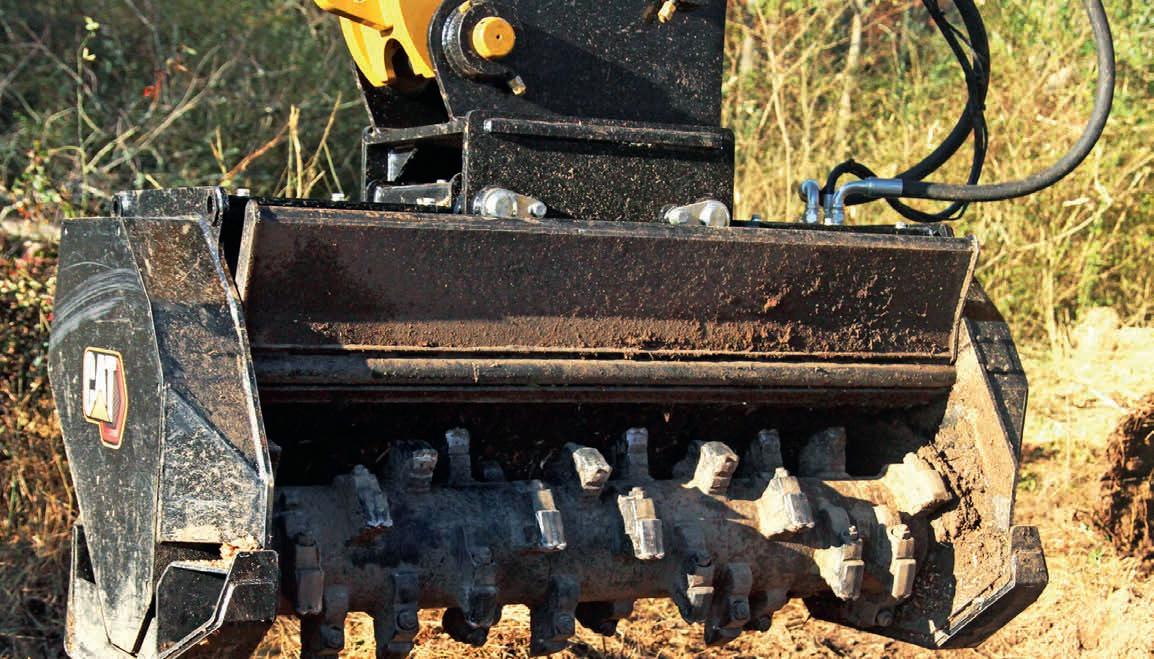

applications.

carbide teeth cutters, multiple service access panels, and a replaceable poly chain belt.
With its easy-to-maintain design, the HM6015 incorporates a number of safety features to protect both workers and equipment at the jobsite.
With the addition of the new Cat HM6015 model, Caterpillar now offers a mulcher attachment for Cat frontreach machines from 11 tons to 36 tons (10 tonnes to 32.7 tonnes) and longreach front machines from 40 tons to 52 tons (36.3 to 47.2 tonnes).
Key components on this mulcher contributing to its consistent, reliable performance include:
• The variable torque hydraulic piston motor shifts between high speed/low torque and low speed/high torque to deliver speed when it’s needed and power when it counts, and
• Hardened counter blades mounted inside the housing help break down the finished material, which can increase the rate of composting.
Maintaining the HM6015 mulcher is fast and simple. Multiple service panels on the machine provide easy access for quick adjustments, and internal components can be easily removed in the field through the access panels, further simplifying maintenance and reducing downtime. The poly chain belt-drive transmission eliminates slippage on startup, increasing
reliability and reducing maintenance costs, and most of the wear parts are made to be field-replaceable to keep the HM6015 working at peak efficiency.
The ability to adjust the hydraulic mulching door allows the operator to control the material throw, which also increases operating safety, especially critical on roadsideclearing applications or when working near powerlines. Groundlevel primary grease points make daily maintenance easier and safer.
Learn more
A complete list of mulchers, listed by region, is available from the local Cat dealer or by visiting cat.com.
Earthmoving Equipment Australia (EEA) is a huge company representing some very big machinery brands. One of EEA’s owners, Chris Newton, has some great memories of the company’s growth. He’s also very optimistic about the company’s future, especially for Merlo in the arbor sector.
Chris Newton and business partner Michael Smith started the EEA business 12 years ago with a single brand, Thwaites, an English manufacturer of site dumpers.
“We created a market,” remembered owner and director, Chris Newton.
Chris and Mike wanted to grow into mainline construction equipment and were fortunate in picking up a Case dealership, which obviously suited their plans and combined talents. With hard work and good decisions EEA became the number-one Case dealership in Australia and quickly grew its area in NSW. A move into south-east Queensland soon followed.
“From there we continued to grow our range and business,” said the justifiably proud Newton. “We now have eight different divisions and 180 staff, so it’s been a busy 12 years.”
The tree-care machinery division includes Bandit, Hansa and Castloaders, all represented in the 12 EEA dealerships Australiawide.
The inclusion of Merlo came when, as EEA continued to grow interstate, Chris and Mike were looking after the Newcastle area for Merlo, the pair’s first area of representation for the brand.
Previously the Merlo business had been rental, and there wasn’t much information around ownership warranties or client ownership, so EEA began to put in place a marketing plan and sales strategy.
“We began growing the market share through Newcastle and all the way up through to south-east Queensland and Bundaberg,” said Newton. “We rebuilt the brand and started picking up more retail-based customers.
“It wasn’t the easiest time when we first started,” he reflected. “We had Covid issues, stock issues and so much more, and that held us back quite a bit. But growth with Merlo has been
Merlo roto telehandlers have really changed the game “ ”
fantastic. Sales have increased yearon-year.
“The dealer conference in Italy last year gave us an insight into the company. There was never any doubt about Merlo’s commitment to quality and safety, especially automated safety, but at the conference we saw the passion behind the brand from the owners of Merlo.
“It was fantastic for us.”
After 12 hard and successful years in the machinery business it seems unlikely there’d be anything much to get Chris excited, but he still glows when he sees revolutionary new equipment.
“The introduction of Merlo’s Cingo range is a really exciting prospect for us,” he beamed.
“They’ve taken an existing product – the smaller tracked carriers and dumpers – and really revolutionised those products into a multi-use, multidimensional asset.
“That’s really exciting! It’s very unique to this market.
“There’s been a lot of issues with the existing players and their tracked carriers. Merlo’s horsepower and resources have really revolutionised that area of the marketplace.”
“The future for EEA is basically continuing to communicate effectively that safety is the number one thing,” said Newton with some intensity. “Safety in all different industries, not just construction or arbor any one area.
“Some areas in the past have taken equipment – telehandlers are a good example – which are very basic, and
from a safety perspective they didn’t have the level technology Merlo offers. As we grow we’re looking forward to educating those industries about considering the importance of safety.
“A lot of people are working in remote locations, and there are important safety features available which will help protect them. We’re keen to educate people in those markets so they can find good solutions for not only production, but for their safety as well.
And EEA’s plans for Merlo?
“Let’s talk about the Merlo roto telehandler, for instance,” said the company director, clearly enthusiastic at the direction of the conversation. “It’s unique to the market.
“Obviously EEA’s arbor experience is pretty big with the Bandit brand, and Merlo’s roto telehandler is increasing OH&S for the arbor industry to levels that haven’t been seen before. You’ve got skilled climbers going up into trees and you’ve got skilled groundies controlling heavy, slung loads, quite often in densely populated areas. And as skilled and as gentle as they can be, Nature has a way of throwing little surprises into the workplace. Unexpected things happen and people are put at risk.
“Merlo roto telehandlers have really changed the game there. Those risks are being reduced by that machine to a great extent. The roto telehandler can mean climbers won’t have to face the risks of being in the tree, and it can handle larger loads, do it safely, and remove the limb or tree with greater efficiency and productivity.”
To learn more of EEA and Merlo, log on to eeaustralia.com.au.
Merlo’s roto telehandler is increasing OH&S for the arbour industry to levels that haven’t been seen before.
Images: Merlo

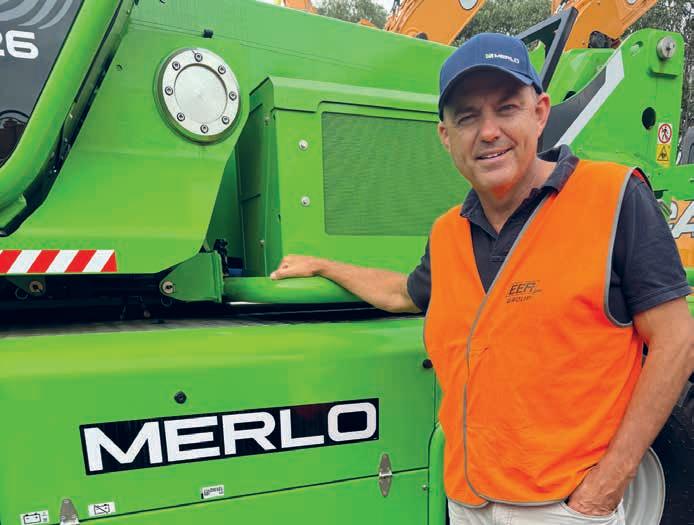

Maintaining green areas often requires the use of several machines. Magni’s Tree cutting attachment was designed to reduce – to one –the number of tools required to maximise efficiency and time.
Magni’s Tree cutting is the result of in-depth research in the field of tree care. Every component maintains perfect harmony between all its elements and meets the needs of this sector, guaranteeing performance and efficiency.
The Tree cutting consists of a grip saw that allows cutting and handling the log in total safety. Manufactured from high-tensile, low-wear Hardox® steel, this attachment is extremely light, allowing all cutting and handling operations to be carried out with great ease.
The gripper is designed to ensure a firm grip and can handle a cutting diameter up to 75cm. Thanks to the Power Tiltator, the gripper ensures 360° rotation, allowing gripping the branch or tree to be cut from any position or angle.
Highly rugged and durable, the springmounted saw box prevents the saw blade bending due to force acting on it. The cutting mechanism consists of a hightensile blade that is easily accessible for

maintenance and is little susceptible to dirt. This minimises maintenance and wear, saves time and maximises productivity.
Since work is not just performed at ground level, the chain is lubricated with grease. Compared to oil lubrication, this avoids oil misting, which would spoil the working area and the cab windscreen. The grease stays on the chain much longer, minimising wear and maintenance.
Thanks to the automatic chain tensioner, the chain always has the right tension, regardless of whether the machine has just been started up or has been in operation for several hours. This means that the working process is not interrupted by a chain coming off.
Available for the RTH range, this kit is designed specifically to make the work of the operator simple and efficient. Because of its features, it is used to maintain roadsides, trails and paths on all kinds of flat and steep terrain.
For this forestry kit Magni TH developed a special remote control which allows controlling all normal cab operations and specific movements of the attachment, making the job safer and more efficient. The colour display shows all boom geometric data to the user on the ground, greatly increasing operator safety.
Moreover, the Italian company created two dedicated options to use this attachment to its full potential…
• Pre arrangement for the Tree cutting device consisting of a series of special cab equipment: protection grid on the windshield, additional rollers on the joysticks for tree cutting operations, cameras with protections and a dedicated HD screen in the cab, front and rear cab working lights and a special filter featuring F7 filter class (CEN EN 779), and
• Boom protection for the Tree cutting device in dusty environments protects the boom and its sections thanks to a metal plate mounted into each of the boom hollows, and additional gaskets at the end of every boom section. This prevents sawdust and debris from entering the boom sections.
Magni’s Tree cutting has been designed with detailed knowledge of the needs of this sector and is thus the ideal all-in-one solution for green maintenance.
Find out more about the Magni Tree cutting at allliftforklifts.com.au
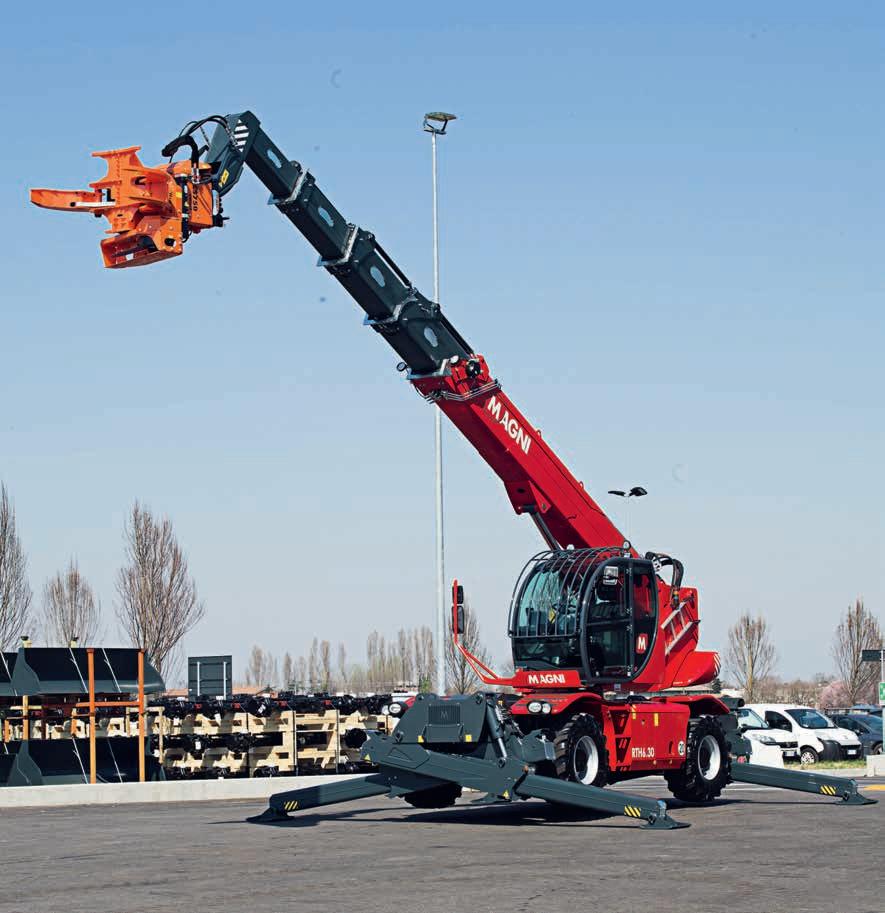
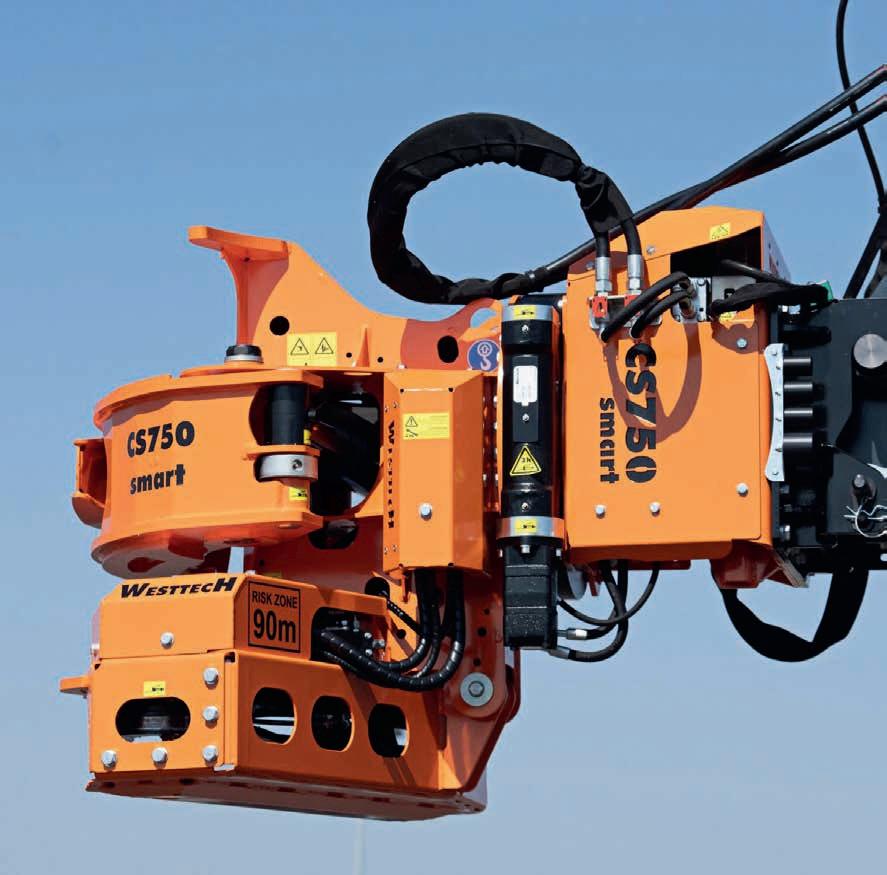
Climbing gear

Husqvarna offers a selection of climbing and rigging equipment to make life in the treetops easier.
Images: Husqvarna
Husqvarna’s range of climbing gear has been specifically designed for arborists and tree-care professionals.
Husqvarna’s climbing gear range includes a climbing harness and ropes designed in partnership with Teufelberger, a world leader in climbing equipment, and Husqvarna has added a storage bag that makes it easy to organise the equipment and take it wherever it’s needed.
Pro standard and harness
Already an industry leader in chainsaws and cutting equipment, Husqvarna has introduced an adjustable, robust and extremely comfortable harness for climbers who spend many hours

In addition to climbing ropes, harness and bag, Husqvarnan also offers a selection of other climbing and rigging equipment.
up in the trees. The harness provides world-class mobility and comfort while helping reduce the risk of injuries and physical stress when working long hours aloft.
“The new climbing gear is fantastic!” said H-Team ambassador Jamie Boston.
“Husqvarna has absolutely top-notch quality gear, and the climbing harness is the hero of the range.”
A wide range of settings allows climbers to customise the harness to different climbing styles and jobs.
“It allows you to have all the attachments and tools you need to go through your day-to-day work,” said Jamie.
To complement the harness, Husqvarna also offers two sets of high-quality climbing ropes which meet both CE and ANSI standards, adding versatility for different rope techniques and super smooth running during both ascent and descent.
Husqvarna has also introduced a gear bag for storing, organising and protecting the climbing and rigging gear. The user-friendly and durable 70-litre gear bag is made of high-quality fabric and includes a reinforced bottom, a helmet storage lid at the top, and side zips, allowing users to have easy access to all their gear, no matter the conditions, making work both easier and more efficient.
In addition to the climbing ropes, harness and bag, Husqvarna also offers a selection of other climbing and rigging equipment to make life in the treetops easier. This includes a chainsaw lanyard with an anti-shock feature that reduces the impact if the chainsaw gets caught in a falling branch or other object. Plus, the range also includes:
• A sling
• A work positioning lanyard
• Rigging rope
• Prusik
• A friction saver, and
• Accessory carabiners (none PPE). Husqvarna’s arborist equipment is made of the highest quality materials and covers the many needs of climbing and rigging, and will soon include a range of purpose-made ropes with dimensions and colours to suit a broad group of professionals.

“I’ve used other products in the past,” said H-Team ambassador Kiah Martin, “and my preference is for Husqvarna.”
“The reason for that is quality product and quality people, and really good research and development. If we can keep developing products to make them safer, more functional, more durable, to reduce the fatigue on the user, and that the user has been involved in helping develop…it’s a beautiful collaboration.
“It doesn’t matter what industry you’re from, that can only be a good thing.”
Husqvarna’s long-term goal is to offer revolutionary equipment for arborists and tree care professionals.
To see the entire range log on to husqvarna.com/au, and the Husqvarna Autumn Catalogue is out now!

Sam Lucas kicked off his life in arboriculture as an 18-year-old. Over the years he’s developed a hard-working outfit, and Sam’s happy association with Monitor goes back more than decade.
Lucas Tree Services specialises in tree removal, pruning and maintenance throughout Victoria, and owner Sam’s pride in his company’s success is mixed with a happy outlook and easy manner.
“I started the business when I was 18,” he said with a grin. “I feel a bit old saying that now, but basically I got into it as a job, started a career path with my wife, and we’ve just excelled from that point.”
Since the earliest days using Rayco machinery, Sam and Lucas Tree Services has enjoyed an excellent relationship with Monitor.
“From when I started as one-man band with one stump grinder and one wood chipper, and was struggling to get a business going, Monitor has been great,” related Sam. “The respect and support
The business Sam and his wife built has been a successful one. Case

they gave us at a business level was amazing – whenever we had a breakdown they supplied us with machines – they’re quick on servicing, and very friendly,” he recalled. “Even now, Monitor respects all our staff and gives us the same level of service they gave us 10 and 12 years ago when we were starting out.
“It’s been a great working relationship. We’ve been able to build a business with the backing of Monitor and I couldn’t speak highly enough of them.
“At the moment we’re running up to seven crews a day with our current fleet,” said Sam. “Most of our work is for local government and power authorities throughout metropolitan Melbourne. We’re currently active for over 10 councils and one power provider, and all our equipment runs pretty much daily on those sorts of works.”
The equipment Sam’s talking about includes CMC lifts, a couple of Först chippers, Rayco grinders and no less than five Morbark woodchippers, all from Monitor.
“The machines are always compliant and we’ve never had an issue with them,” said Sam. “They’re reliable, meet all our current emissions standards and environmental policies and, yeah, they’re doing great.”
The latest addition to the Lucas Tree Services’ fleet is a Morbark Beever 1821 heavy-duty industrial woodchipper.
With its high-capacity and lighterweight design, the 1821 compact chipper is an ideal unit for residential
A dual-sided, chambered air-impeller system increases chip-throwing velocity and reduces dust and material blowback out the infeed to pack more into the chip truck.


The wide infeed opening with dual infeed rollers, and an oversized 18" diameter top-feed wheel with straight flow-through infeed, easily climbs over material, reduces drag and increases chipping efficiency.
tree services, utility line clearing, vegetation management, maintenance contractors and municipalities. The dual-sided, chambered air-impeller system increases chip-throwing velocity and reduces dust and material blowback out the infeed to pack more into the chip truck, increasing efficiency.
The powerful TorqMax™ top-feed wheel-compression system generates more than 5060kg/m of material-pulling force and the wide infeed opening with dual infeed rollers, and an oversized 18" diameter top-feed wheel with straight flow-through infeed, easily climbs over material, reduces drag and increases chipping efficiency. A full-length channel chassis with cross bracing increases structural strength while maintaining low unit weight, and a full 360° hydraulic chute with swivel discharge and adjustable height puts chips right where needed without removing the Beever from the tow vehicle.
It’s a long-lasting, durable machine backed by a world-class parts and service support team at Monitor.
Other highlights include:
• Dual infeed wheel with TorqMax™
top feed wheel compression system, hydraulic lift assist, spring assisted down pressure and manually applied hydraulic down pressure at the valve handle
• A reversing automatic feed system
• Enclosed engine with gauge panel, radiator fines screen and slide rails for belt adjustment
• Fuel tank sight gauge, drain plug and shutoff valve, and
• Hydraulic tank shut-off valve, drain plug and clean-out cover.
Sam’s total satisfaction with the 1821 is on par with his customer satisfaction when dealing with Monitor.
“We bought the 1821 mainly to upgrade our fleet a few years ago,” he told us. “It was one of the first Morbark machines we actually bought. Since then we’ve ended up buying five of them and all the guys have pretty much converted.
“We’re lovin’ the good infeed, plenty of power, the lift and crush is perfect, it’s very user friendly and very low maintenance.”
“It’s a great machine.”
Tyres
Hitch
pintle ring

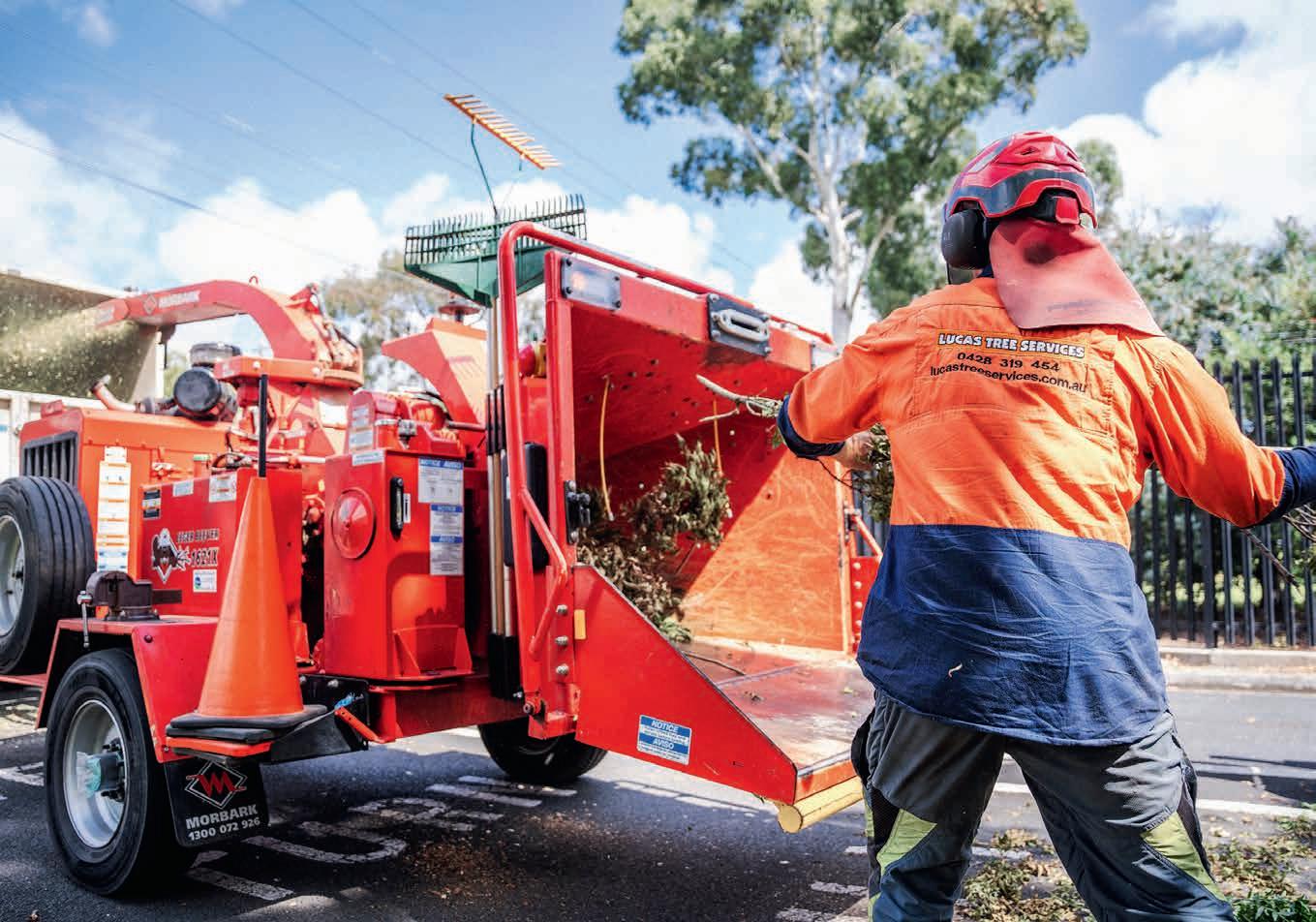

Scan the QR code to check out the latest deals from Husqvarna!
Are you in search of a chainsaw that can handle even the toughest jobs? Husqvarna’s lineup of professional chainsaws are expertly crafted to tackle the demands of all-day cutting, felling, and pruning with ease. With unbeatable power, exceptional performance, and superior design quality, our professional range is built to help you get the job done right. Try one for yourself and experience the Husqvarna difference. Learn more at husqvarna.com BONUS!
Receive a bonus SPIRE Arborist Helmet valued at $209 with the purchase of a T525 or T540 XPII Chainsaw



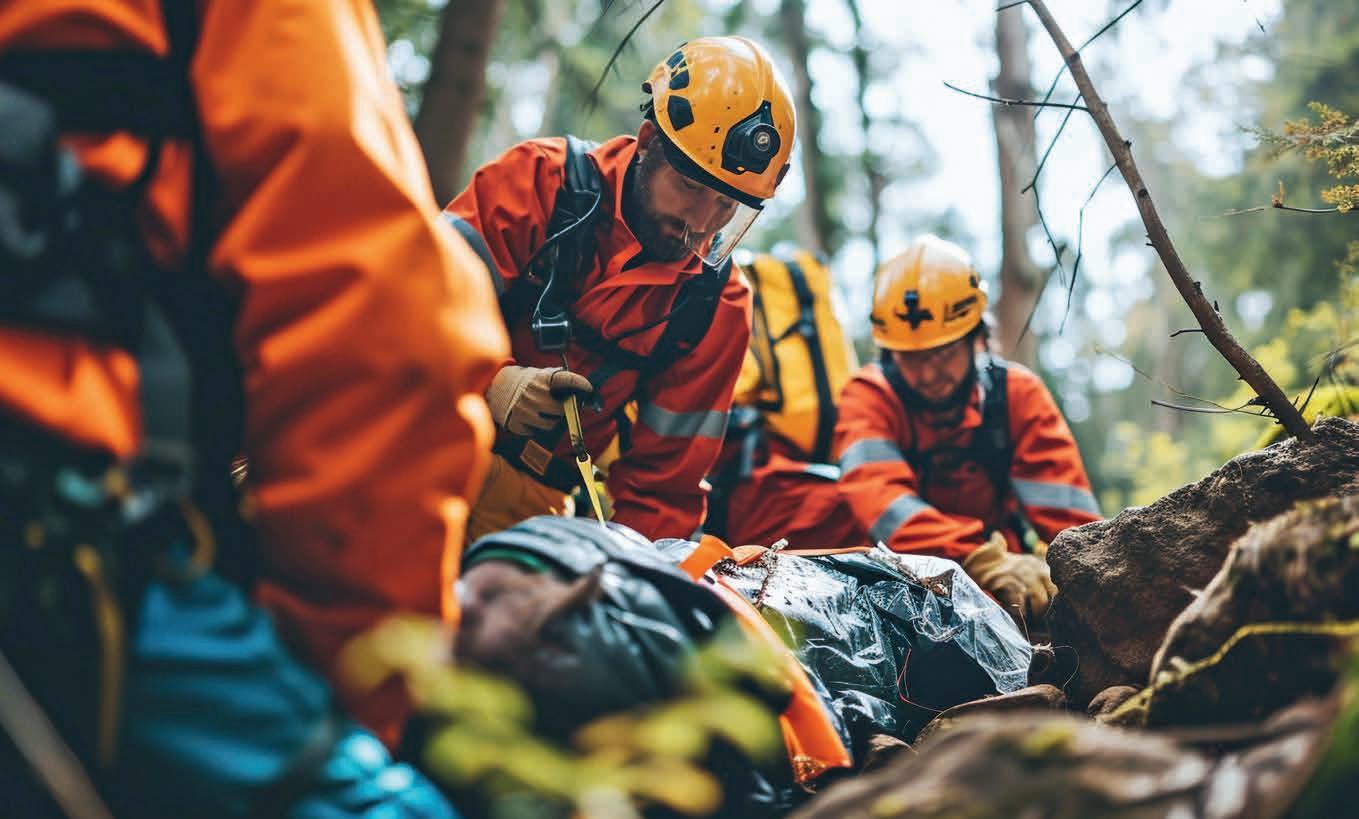
Injury reporting or notification to WorkCover/ WorkSafe is only required in the case of notifiable incidents. Image: Shining Pro/Stock.adobe.com
The Federal Government continues its campaign targeting employers who underpay employees according to the relevant employment legislation. Brian Beecroft of the Timber Trade Industrial Association highlights some important changes in legislation.
Commencing January 1, 2025, intentional underpayments of wages by a business will be a criminal offence.
Employers may commit an offence if they owe money to an employee under the Fair Work Act or an industrial instrument (like an award or an enterprise agreement), and intentionally engage in conduct that results in a failure to pay on or before the money is due. This can include failure to make required superannuation contributions.
A Voluntary Small Business Wage Compliance Code will be established before the changes take effect, and compliance with this code means a small business won’t be prosecuted if it underpays its employees.
TTIA will ensure members defined as small businesses will have some support through this compliance code.
Companies prosecuted face penalties three times the amount of the underpayment if a court can determine it, or $7.825 million, whichever is greater. If the court can’t determine the underpayment, the maximum penalty is $7.825 million.
Individuals can be imprisoned for up to 10 years, be fined either three times the amount of the underpayment if the court can determine it, or up to $1.565 million, whichever is greater; or be both fined and imprisoned.
While the new laws arguably seem to be quite heavy handed, particularly in relation to imprisonment, the Fair Work Ombudsman has attempted to reassure employers these laws don’t apply to those who unintentionally underpay their employees, or inadvertently pay the wrong amount due to an error.
That remains to be seen, and as an association, TTIA will put the spotlight on any future prosecutions.
In summary, the Fair Work Ombudsman will, once the offence takes effect in 2025, investigate suspected criminal underpayment offences.
These developments once again highlight the absolute importance of TTIA members arranging an appointment with our Legal Officer for an up-to-date TTIA wage audit of all wages, policies, and templates. Contact our office on (02) 9264 0011, or Janet Gilbert on 0414 557 235, to arrange an appointment.
Members often ask the TTIA’s National Timber Employers Hotline the question, “How serious does an injury need to be
 Brian Beecroft TTIA CEO.
Brian Beecroft TTIA CEO.
before there is a requirement to record it?”
For instance, if an employee suffers a minor cut at work that only requires a band-aid, should the incident be recorded?
Minor cuts that can be fixed with a band-aid are not explicitly mentioned in relevant legislation or in the Workplace Injuries and Disease Recording Standard – AS 1885.1-1990 which sets out good practice regarding injury recording. The wording of relevant workers compensation legislation and the Standard do imply, however, that even minor cuts should be recorded.
The Standard recommends all occurrences should be recorded, including ‘no lost-time’ workplace injuries or diseases – that is, those for which first aid and/or medical treatment was administered. Applying a Band-Aid would be considered providing first aid, so the Standard’s recommendation would be to record such injuries, including while working at home.
Workers compensation legislation contains the relevant legislative requirements. In New South Wales, for example, workers compensation legislation requires employers to keep a register of injuries that is readily accessible in the workplace. The register is a record of any injuries suffered by workers, whether they result in compensation claims or not. This, too, implies minor injuries are not excluded from recording requirements. Employers can draw up their own injury register; however, it must include:
• The name of the injured worker
• The worker’s address
• The worker’s age at the time of injury
• The worker’s occupation at the time of injury
• The industry in which the worker was engaged at the time of injury
• The time and date of injury
• The nature of the injury, and
• The cause of the injury.
Recording minor injuries may help draw attention – and prompt remedial

action – regarding sources of injuries. Members should note that even minor cuts can become infected, especially in environments where workers may be exposed to blood-borne pathogens or other contamination.
Reporting of injuries is a different matter from recording them.
Injury reporting or notification to WorkCover/WorkSafe is only required in the case of notifiable incidents –those resulting in death or serious injury, or dangerous incidents such as uncontrolled spills, leaks, or explosions. Minor cuts don’t need to be reported unless your organisation requires those incidents to be reported within its own internal safety-management system.
TTIA operates a fully functioning, in-house WHS unit. If you have any further enquiries regarding workplace injury reporting obligations, please contact our WHS Manager, Ken Hocking, on 0418 280 335, or the TTIA Hotline on (02) 9264 0011.

Dave Crispin, senior arborist at Treeswest Australia and Arboricultural Association of Western Australia (Arb West) committee member, highlights some of the effects and management of high temperatures.
It’s so hot even the ice-cream truck melted.
Jokes aside, Western Australia is experiencing one its hottest Februarys on record.
I hate to use the word ‘unprecedented’ – it became part of our lexicon during Covid (and there’s another one – ‘Covid’) and like most people I’m over Covid and anything else that is associated with it –but unfortunately, it looks like it’s here to stay, just like our severe heatwave here in Western Australia.
Temperatures in and around Perth in January and February were averaging between 40 ºC and 45 ºC, and it seems to be happening more frequently as our climate changes.
How do trees cope in the intense heat?
Unlike us they cannot uproot and hide under the shade of one of their own.
At a recent lecture the theme was, ‘Action - Reaction = Consequence’.
Over the preceding weeks I’ve seen this play out on several occasions, manifesting as canopy decline due to sun scorch.
Like most consultants, I’m asked to look at many trees, and one occasion recently I was asked to look at a stand of Celtis australis (European hackberry). Several of the trees had recently been crown thinned, (Action) at the client’s behest, resulting in minimal foliage in the upper crown, which ordinarily would protect it from the midday sun. The tree had tried to respond, (Reaction) but it was too little too late. Consequence –all the main extended lateral branches radiating out from the trunk, exposed to the intense sunlight, had suffered major sun damage. As a result, the upper side of the branches had delaminated, peeling back to reveal the xylem tissue. The periderm (outer bark) was peeling off in sheets.
We can cover up, trees cannot.
Consider this: when the ambient temperature on Perth streets reaches
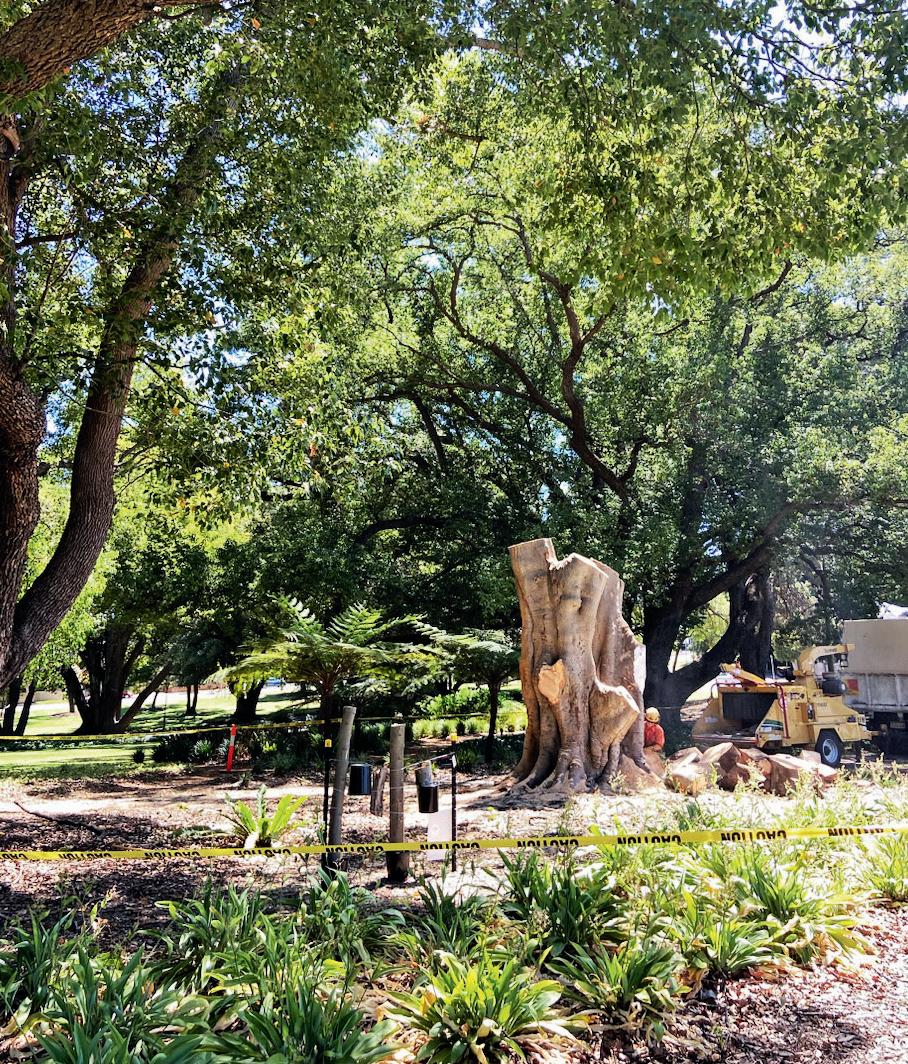
around 35 ºC, and the direct sunlight hits the bitumen road surface, it’s not uncommon for the road to heat up to 50 ºC and beyond. The impact this has on the root zone, especially the lower order roots, can be disastrous. Many shallow-rooted trees like the humble Corymbia calophylla (Marri) have been lost recently.
Various trees have different tolerance levels to heat. Some cope better than others.
When Sydney had its record-breaking heatwave in 2020, 12 days over 40ºC, some trees died, while others coped
very well. Thinking that native trees would fare better than exotics was not the case. Both exotics and natives took a hit. Trees that had a low heat tolerance and died included the Acer rubrum (red maple), Liriodendron tulipifera (Tulip poplar), surprisingly, Banksia integrifolia (Coastal banksia), and Tristaniopsis laurina (Watergum). Others suffered severe heat stress, and eventually had to be removed.
Trees that were more resilient, and seemed to cope better, were the Ulmus parvifolia (Chinese elm), Fraxinus excelsior (European ash), Callistemon
viminalis (Weeping bottlebrush), and the Brachychiton populeneus (Kurrajong).
The info came from Misha Ketchell’s 2023 We need urban trees more than ever, published on theconversation.com.
Heat stress on trees in the urban environment is more prevalent given the retained and reflected heat from buildings and infrastructure, more so than in a rural environment. Heat stress reduces the tree’s ability to photosynthesise and increases photooxidative stress (chloroplasts are damaged inhibiting photosynthesis). If prolonged, this can lead to premature leaf abscission, leaf chlorosis, and decreased growth.
Extended periods of intense heat like those we’ve been experiencing, coupled with drought-like conditions due to declining rainfall, are a major cause for concern, especially for our local amenity trees. Residential trees can be given supplemental water by the property owner. Street trees, not so much.
In future, local government will have to invest more time in planting heat- and drought-tolerant tree species, and allocate more funds towards tree watering to reduce heat stress and tree mortality during the hottest periods of the Western Australian summer.
Looking after our own Arboriculture, and horticulture, are outside professions, it is part of the allure when talking with young people ready to sign up for what I consider to be one of the most rewarding professions there is. And summer is typically a favourite time of the year for working outside, but it does come with its challenges. Heat exhaustion (when your body loses excessive amounts of water and salt), is a real threat, and one that must be taken seriously. Plenty of hydration and electrolyte replacement is as essential as sunscreen and long sleeves when working outside on high-temperature days.
Every surface exposed to the sun has the potential to give first- or seconddegree burns, so gloves are an essential part of PPE (Personal Protective Equipment).
First-degree burns affect the outer layer of skin – the epidermis. They are painful, are usually accompanied with swelling and redness.
Second-degree burns affect the outer and underlying layer of skin, epidermis

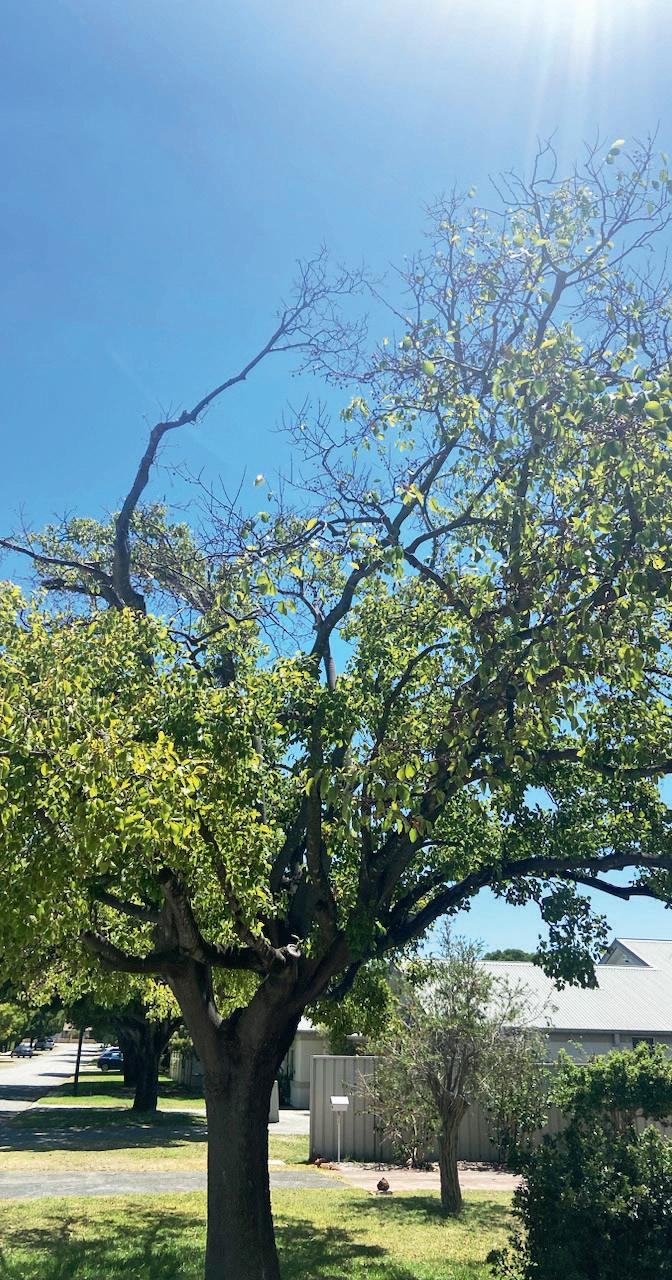
and dermis. Second-degree burns cause pain, redness, swelling and blistering, and the person should seek medical advice.
CPD Trees, run by Mick Byrne, operates in Perth Hills, an area of dense forest.
Mick is a long-standing Arb West member and has had to stand down his team on a number of occasions this year due to Harvest and Vehicle Movement Bans (HVMB). HVMB’s are the responsibility of the local government authority, and as a rule they’re only issued on the actual morning. I asked Mick how he managed to find work for the guys when there was a work ban in place.
“After ringing the clients and cancelling the work for the day, I have to do a quick ring around and try and find work where there isn’t a ban in place,” he explained. “If not, I must stand the guys down.”
He mentioned on high fire risk days when they can work, when the appropriate measures are put in place, electrical saws are used, regulation


fire extinguishers are taken out, and the guys are rotated to take regular hydration breaks.
All being said, you can’t beat working outside in this beautiful state, whatever the weather has to offer. Arriving back at the yard on 40 ºC day to be greeted with ice-cold icypoles, and iced-watermelon makes it all worth it.
The Polyphagos Shot Hole Borer (PSHB) continues to cut a destructive path through Perth’s urban tree population. In a recent press release it was reported a number of Perth’s famous landmarks had reported infestations, and a number of culturally significant and historic trees would have to be removed –or at the least be heavily pruned.
Locations such as Hyde Park, established by European settlers in 1897 under the name ‘Third Swamp’, has a rich tree history, with records of Ficus and Platanus being planted in 1897, and Pinus sp. and Jacaranda planted in 1912 and 1921 respectively, 100-year-old trees –and some even older – have become infected.
Driving past Hyde Park recently I noticed one of our Arb West members, Morin & Sons, had two crews at the park removing a large Ficus macrophylla var. hillii. Such a magnificent tree meeting an untimely end! Speaking with Alex Morin, the business owner, he mentioned this was only one of many trees he had recently removed for the Department of Primary Industries and Regional Development.
One of Perth’s most notable landmarks, Kings Park, so named in 1901 to mark the ascension to the throne of King Edward VII, and sitting on approximately 400 hectares, has a host of trees favoured by the borer. Unfortunately, there are now a number that have to be removed.
The thought of losing so many of our historically significant trees, part of our Western Australian heritage, is devastating.
Take note: as an association, it is incumbent on Arb West to disseminate current, factual, practical advice to our industry, members or not, to try and contain the spread of PSHB. I suggest other associations in other Australian states watch this space!
To learn more of Arb West and its membership, log on to arbwest.com.au.

The TCAAA’s Jim McArdle points out there’s a phenomenon that eludes most arborists when discussing big leans in trees.
Most lay people, non-arborists, would say a tree with a lean is a common threat of failure.
This would only be the case in a solitary tree in moist or saturated ground, or a tree facing the prevailing wind. Some trees lean due to the removal of adjacent trees causing them to compensate a new foraging and support system in order to remain viable.
Why don’t trees lean toward the equator?
With age some do, like Araucaria columnaris (Cook pine). Phototropism is the cellular response to light. For example, most indoor plants on windows to grow toward the sun. Trees have many cells that are opportunistic towards the light, often the sun, or at least towards a gap where they’re exposed to light. The exception is roots which grow away from light (skototropism).
Can a leaning tree be retained?
It would be wise to retain a leaning tree unless it’s hazardous, and the AQF level 3 or level 5 arborist can best ascertain this through testing the roots at the SRZ distance or interface from structural to woody feeder roots. A table of SRZ calculations is given in AS4970 2009.
Key areas of concern when assessing or doing a pre-climb questionnaire would be observing a weight-to-balance ratio deficit, slenderness, lift of root plate, root rot, or fracture in the lower or mid stem within the tree, and whether the tree is naturally grown or from a pot, having no tap root; one way of addressing these issues is root test investigation.
We were called to a local job where a
tree was moving and the lean toward a house was raising concerns. Within the hierarchy of control there was limited access, so we couldn’t use an EWP, crane or helicopters, and stabilising the tree was a challenge. After tying the tree to an anchoring point and two large and stable trees nearby, the weight-tobalance ratio was corrected and the moving tree was dismantled.
Basal root rot and decay can easily displace a tree and cause it to lean and fail. If saturated for long periods, moisture under the soil tends to move mycelium to up the tree’s vessels towards branches. Unfortunately, it can cause branch failure or lead to root loss and failure or leaning.
Root tests can offer some hope of identifying, root vigor (energy), vibrance (appearance) and vivacity (root tenacity or tendency to spread rootlets and colonise) in the area of support. The




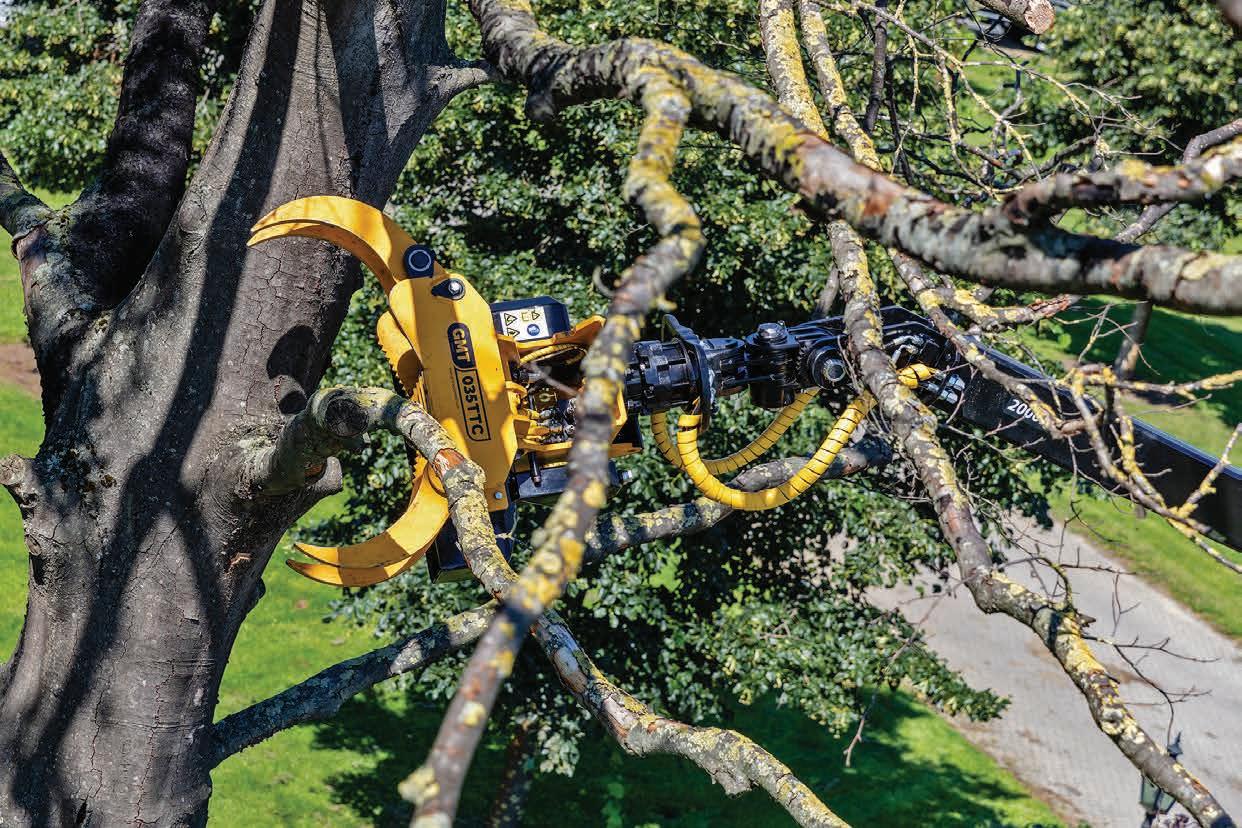
A safer, more productive and innovative way to handle any type of tree work: remote control
Canopy Lift Knuckle Boom Crane with Mecanil SG200 remote rotating grapple saw is a ground-breaking solution which is revolutionising the tree industry. Available for hire nationwide, it allows the operator to access any type of tree work via remote control, in a safe and productive way. No direct tree access or climbing is required.
• Emergency tree removal
• Storm-damage tree removal
• General tree removal
• Available for hire in NSW and interstate
• Crane reach 26m – lift 1.25 tonnes
• Crane reach 29m – suitable to access trees up to 35m
• Crane lift at 4m – 11,400kg on hook and chains
Hire a licensed Canopy Lift knuckle boom crane with grapple saw attachment and operator for tree-care work now!
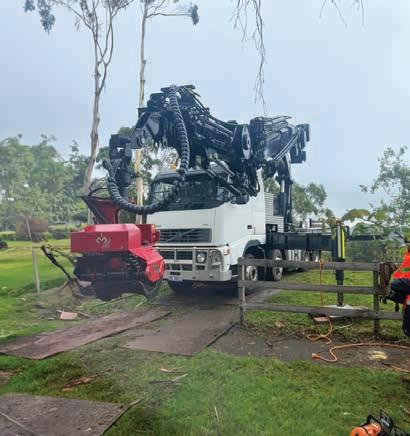

Trees like the Santalum acuminatum (Quandong), have been utilised as grand walking vistas and entrances. Image: ssmalomuzh/Stock.Adobe.com
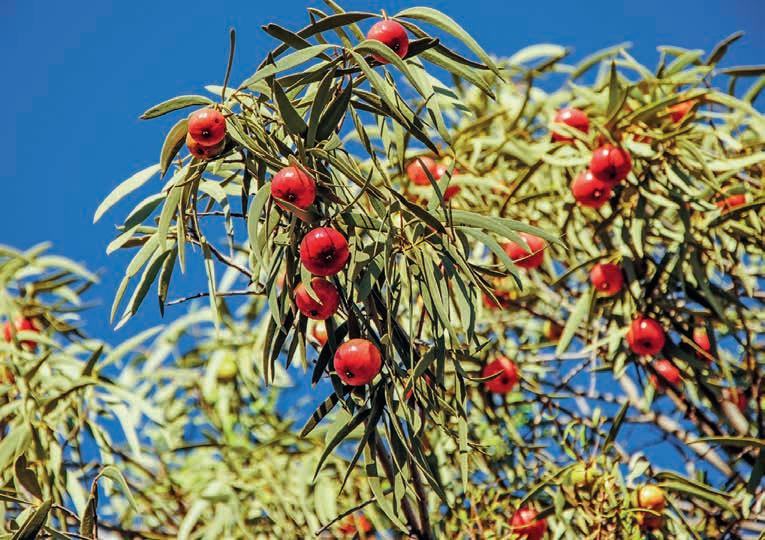
issue with identifying species or types of trees is when a vivacious root system overcrowds or outcompetes with a support which could be established as typical or atypical habit. The arborist must know their species and where the zone of rapid taper is located.
Root-plate lift can be established by utilising a foot mallet or probe first, then reviewing the area around the structural root zone.
The foot mallet is simply sounding the ground with the feet or a mallet and determining if any air pockets are found, indicated by lower resonance of the mallet effect. A probe can also be utilised when checking the root zone area for consistency and density in the soil medium, or whether resistance is freely given in the areas of the mallet test – ‘pockets of air’. The structural root zone is the interface of stability and trees would either be windthrown commonly – but not always – at this distance.
When determining compaction, a probe may utilised, but make sure it’s insulated.
Hard-surface areas, drainage and moisture collection areas (pools) are examined for their impact on the system and whether they are positive or negative contributors to support. Negative contributors will act like constraining forces on the root system, reducing root-plate support. Positive contributors like other enmeshing tree
roots of a similar species will act as increasing support.
Contaminated soils may have a pedal structure and high compaction rate which allow for surface-dwelling roots and poor root-plate adhesion. This is a negative contributor and can cause windthrow or failure.
Competing species in root systems can have a negative contribution on the leaning tree if the roots of the adjacent tree area are invasive and highly charged with opportunistic features. Trees like Celtis sp. (Hackberry), Ficus sp (Strangler Fig), Ficus elastica (Rubber), Ligustrum sp. (Privet) and Erythrinas sp. (Coral), and Ailanthus altissima (Tree of Heaven) are key tree species which will outcompete native vegetation. Native trees which may contribute to competing are Eucalyptus robusta (Swamp Mahogany), Ficus watkinsiana (Nipple Fig) and Casuarina glauca (Swamp Oak).
Where leaning trees are the result of two separate trees competing for root stability on the same point in the landscape, the issue is affectation by the constraining forces. If the tree which is leaning is not the feature tree, then it could be removed. But if it is the feature tree, it would need root-test investigation to maintain the status and to possibly engineer a solution to retain the tree. One simple way of restraining a leaning tree with susceptible root attachment is to buffet the stem against the lean with a stay. The load presses
into the timber and the ground may be battened for additional support, particularly in sandy soil or wet soil.
Other options may include engineered cabling with secured anchorage rated to the appropriate tonnage of tension.
Any system introduced would be ideal in increasing support.
On review of the draft AS4790 20024 standards, no additional information is given in the sphere and arborists can change the TPZ to a more subtle oval shape with roots biased towards the lean or away from the lean (note the TPZ is usually a circle and can also be moved if conditions onsite warrant it, including having a cliff one side but still inside a measured TPZ, having a rock platform in the TPZ, or a slab without roots underneath).Major encroachments must have root investigations as per AS4970 2009 by the arborist.
Where the tree roots are leaning with the prevailing wind, the tree has most commonly adapted to the wind force and the windsail area reduces during wind force from weather events on the prevailing wind. Where the lean is into or against the prevailing wind there could be an issue of increasing the wind force in extreme weather and the windsail increases instead of diminishing. The lean has bearing on whether the tree has additional force it can either dissipate or not, hence failure or possible windthrow.
Trees generally weather storms and can lean over to the direction of the prevailing wind, making themselves a smaller target to windforce.
Ken James has an excellent article on wind dynamics and his table indicates typical effects of winds at different speeds on trees.
Note the uprooting of trees at between 89kph and 100kph.
Tree effect Wind speed
Leaves rustle 6kph-11kph
Whole trees in motion 51kph-61kph
Twigs break 63kph-74kph
Branches break 76kph-87kph
Trees break or uproot 89kph-100kph
Hurricane 117kph or greater
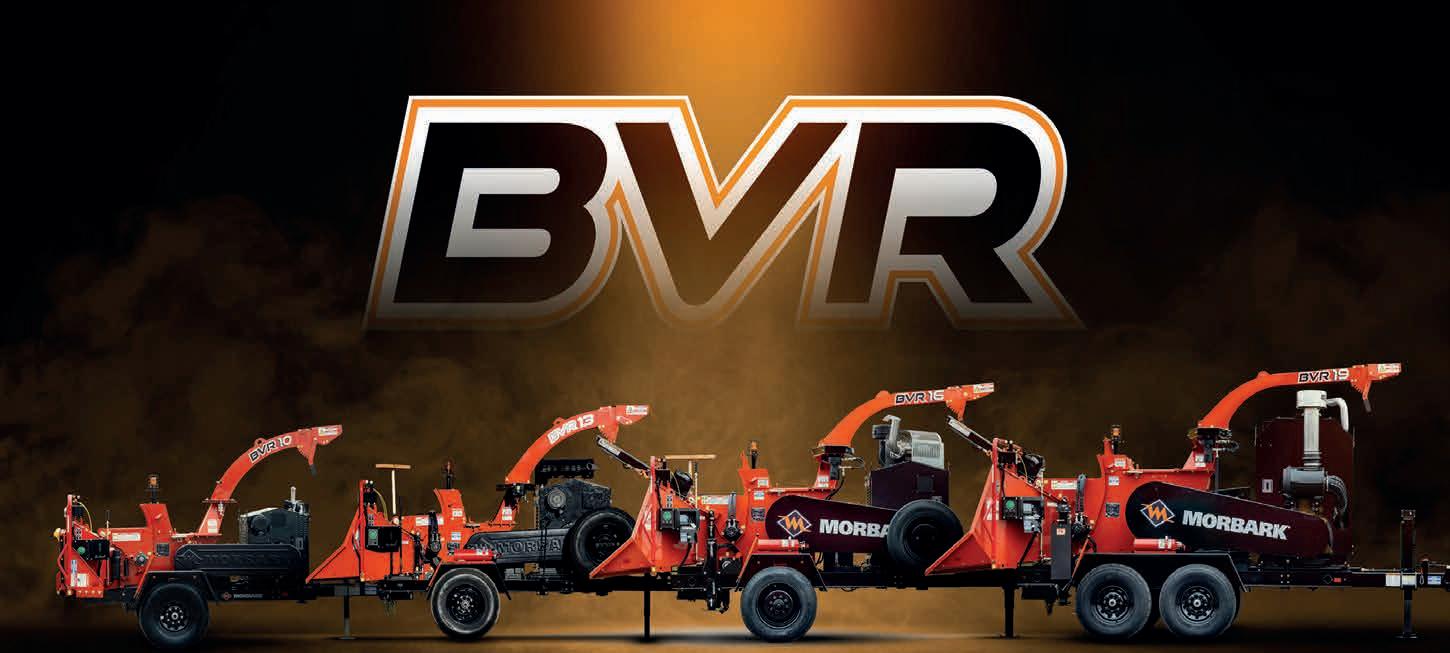



The BVR line of brush chippers builds upon the legacy of Morbark’s innovation in the tree care industry through an updated modular design. The new configuration streamlines the equipment’s overall upkeep and maintenance routine, reducing customer downtime and increasing overall productivity.
The BVR brush chippers also feature Morbark’s proven and patented ZeroClutch®. Our ZeroClutch removes the anxiety of engaging the chipper drum, damaged drive belts, and burned clutch discs and elevates the customer’s operating experience. Customers will now simply start their brush chipper, throttle the machine to full RPMs, and engage the feed control bar.
The BVR brush chippers also feature a Reverse-Style Pivot Assembly, which contours the radius of the drum, reducing dead space between the feed wheel and the drum. This gives the machine a
mechanical advantage for increased down pressure, providing optimal chipping results when working with challenging materials.
Other notable innovations to the BVR line include:
• Infeed-Mounted Control Panel - Provides a more convenient access location for operators
• Side-Load Anvil - Four-sided, side-load anvil makes changing the anvil easier.
• 360-degree manual swivel discharge chute - Offers multiple locking positions for greater operator control over chip discharge, and a
• 3-position Electronic Control Bar with Dual Safety Pull Cables, designed to keep safety a top priority while working on a jobsite.
For eqiupment availablity, request a demonstration or quote, contact your local Morbark dealer.
Monitor Industries - NSW/QLD/VIC
Ph: +61 1800 025 024
www.monitor.com.au
49-50 Cassola Pl, Penrith, NSW 2740
1/9 Brumby Street, Seven Hills, NSW 2147
143 Gunnedah Rd., Tamworth, NSW 2340
191 Magnesium Dr, Crestmead, QLD 4132
2/2 Alta Drive, Caboolture, QLD 4510
24-28 Williams Road, Dandenong South, VIC 3175
75 Willandra Drive, Epping, VIC 3076
Stevens Products - New Zealand
+64 9 275 0443
www.stevensgroup.co.nz
293 Landing Drive, Mangere, Auckland, NZ
Scan the QRCode to learn more about Morbark’s new BVR Brush Chipper Line.
BVR10 BVR13 BVR16 BVR19Leaning trees within a patch would be typical as they are searching for light, and phototropism can produce artistic leaders and interesting canopies.
One typical large leaning Ironbark tree I’ve observed ever since I was a young child has always leaned extensively north next to my bustop and toward the road.
When investigating the site, the road is on the north with the swale approximately 3.5 metres from the stem, and the south is a field and biodiversity area on the nature-strip curtilage.
From the edge of the patch trees are subjected to additional loading and therefore there is a propensity to take on an increased load which may influence the rootplate and a lean.
Species, such as the Araucaria columnaris (Cook Pine), are known to lean toward the north. Large trees are known to lean with different soil-profile densities.
Trees leaning in protected areas are usually acceptable to be retained. Large trees which have shifted from natural conditions may have greater difficulty
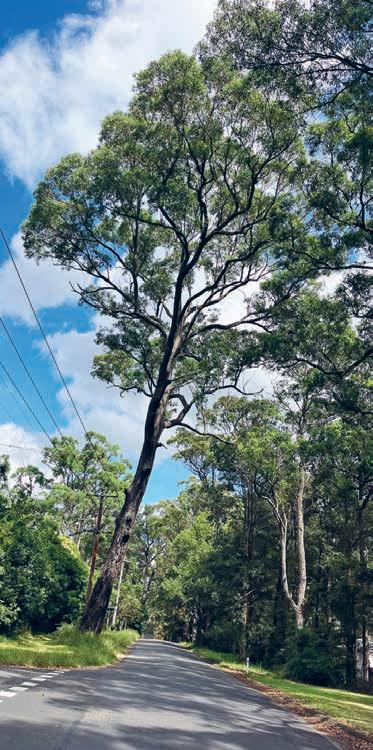

in re-establishing their position and stabilising. Trees with larger buttress roots are difficult to move, but over time increasing force can shift. Trees on moving soil, slip areas or glacial movements, riverbeds, cliff faces and next to highways where vibration is constant can have difficulty in remaining upright. When trees lean their root system may be exposed, or if they’re supported against a fence or another tree, it may be a case of condemning and replenishing the tree.
In most coastal areas where prevailing salt in the air and constant moisture move a tree in inclement weather, trees can adapt to the conditions or salt injury can take effect on windward side. Some adaptions which are considerable feats include additional ribbing of response wood, additional stem support from advantageous roots, pneumatophores (Mangrove roots) and new epicormic stems which grow vertical and input large reserves of sugars back into the stem.
Historically the hanging tree at Parramatta had a substantial lean and was utilised in hanging convicts. I have to admit that’s one tree I am glad to see a cultural disposition of loss.
Trees leaning into spirituality listed in the Bible include the Acacia, Almond, Almugwood, Balsam tree, Broom tree, Cedar, Cypress tree, Fig, Juniper, Myrtle
tree, Oak, Olive trees, Palm, Pine and Aleppo – that’s besides the symbolic trees, including the Tree of Life and the Tree of Knowledge.
The Budda sat under a Ficus religiosa (Bohdi tree) and other trees like the Anandabodhi tree. Birthing trees have similar role in that they present a featured, protected area, usually in their root buttress, allowing for birth to be semi-protected.
The dying stockman from Henry Lawson lay under the shade of a coolabah tree. And it’s thought the Kelly gang had their last stand at Stringybark Creek in Toombullup State Forest near Benalla laid under the Stringybark tree.
The national tree of Australia is the Acacia pycnantha (Golden wattle) but it’s hard to find one flowering at our historic government buildings. It’s also known that Acacia aneura (Mulga wattle) are the most common in Australia, with incredibly dense, heavy and supportive roots. The Ginko biloba (Ginko) is a dinosaur tree that generally leans with a deep taproot and has medicinal qualities improving circulation and keeping memory sharp for the brain, making the nervous system more focussed and synapses responsive. It’s ideal for HSC students with the disclaimer of use for epileptics, heart conditions if pregnant, and so forth.
Designing environments with Australian trees like the Callistemon sp (Bottlebrush), Corymbia ficifolia
(Western Red) and Santalum acuminatum (Quandong), where we survey the natural environment for inspiration including trees leaning, or trained to lean into another, to create an avenue, have been utilised as grand walking vistas and entrances.
Although most of The Leaning Trees scattered in the Greenough area are located on private property, they can’t be overlooked by anyone driving along the Brand Highway. The tree trunks lie horizontal to the ground and have become somewhat of an icon, a bizarre natural phenomenon caused by airborne salt blown in off the Indian Ocean.
Bonsai has also given the preference of leaning – on a microscale – to present a unique artistry in tree habit. The lean is always a feature that can mimic age as some aged and weathered trees can, in difficult environments, have excessive leans.
Trees which have failed and which are lying on the ground are not leaning.
Leaning trees within a plantation are not usual as they are difficult to harvest. Monocultures are used in harvesting, although promoting a species can be difficult to control with infectious diseases.
As a child we had a ‘horse’ tree which was over a cliff and we would gladly ‘ride’ it with a brother or playmate. It was anchored into a crevice and would be very difficult to dislodge. This type of tree, although a feature, should be constantly assessed if left in a public school or facility. If removing trees like this on the basis of a leaning tree, it can leave us with less budding climbing arborists.
A common issue is children who like to climb trees find the tree they want to climb the most is close to the school fence, offering a sense of freedom or a joyous escape. Even as a child I was scolded for climbing trees and sent to the principal’s office, and that was after the principal told the school not to climb trees!

A tree with a lean is a commonly seen as threatening failure. Sometimes it’s true, but not always.

The Queensland Arboricultural Association continues to watch over and advance arboriculture in Australia’s north.
The recent cyclone that swept through parts of Queensland left a trail of destruction in its wake, particularly impacting Cairns and Southern QLD. As the winds subsided and the rains ceased, arborists rolled up their sleeves to tackle the monumental task of restoring the urban landscape.
The clean-up efforts have been nothing short of extraordinary, with arborists working tirelessly to remove fallen trees, clear debris, and assess damage to green spaces. Their dedication and expertise have been instrumental in rejuvenating communities and restoring a sense of normality amidst the chaos.
However, as the clean up continues, it’s crucial for arborists to prioritise their own well-being. The physical and emotional toll of such intense work can be draining, making self-care essential to prevent burnout. Regular breaks, hydration, effective time management, balanced nutrition, and adequate rest are not just luxuries but necessities in this demanding profession.
QAA sponsorship opportunities: supporting the aboriculture community
At the heart of the arboriculture community lies the Queensland Arboricultural Association (QAA), a not-for-profit organisation dedicated to advancing the industry through education, training, and advocacy. Central to the QAA’s success are its sponsors, whose support enables the association to fulfill its mission and empower arborists across the state.
With sponsorship sales now open for the upcoming year, businesses have the opportunity to align themselves with the QAA and demonstrate their commitment to the industry. These partnerships provide valuable exposure and networking opportunities while supporting initiatives that benefit the entire arboriculture community.
Interested parties are encouraged to secure their sponsorship packages promptly, as opportunities are sold on a first-come basis. For more information

on becoming a QAA sponsor, interested parties can request a Sponsorship Package by emailing office@qaa.net.au or calling the office 07 3821 1488.
Event recap: Empowering Arborists Through Education
Education lies at the core of professional growth in arboriculture, and recent workshops hosted by the QAA have provided invaluable opportunities for arborists to enhance their skills and knowledge.
Bryan Gould’s workshop Managing Trees – adopting a selective approach, emphasised key aspects: selecting trees as landscape anchors; understanding
design requirements; biological tolerances; and functional survival.
Attendees gained deep insights into meaningful tree selection and enhancing urban treescapes. Thanks to all participants for their exceptional dedication to learning.
Craig Reid concluded the Aerial Rescue workshops on the Sunshine Coast.
Rooted in the Minimum Industry Standard MIS304 Aerial Rescue, these sessions covered a spectrum of rescue scenarios and techniques, offering invaluable insights for competitive climbers. Topics included pre-rescue planning, emergency response strategies, access methods, casualty

care, and equipment configuration. Special thanks to Jamie Boston for his assistance with this workshop.
Mark Hartley’s An Irreverent look at Tree Protection on Development Sites workshop returned to Brisbane in March, receiving positive feedback. The QTRA training has also been successful and will be offered again soon. Contact the QAA for training or refreshers.
As we look ahead, the QAA remains committed to providing arborists with opportunities for growth, learning, and collaboration. Upcoming workshops on Objective Writing, Pest, Disease & Damage, Introduction to Mycology & TRAQ promise to further expand arborists’ knowledge base and skillset. Additionally, exciting events such as the Freestyle Comp and the Queensland Tree Climbing Championship (QTCC) offer platforms for arborists to showcase their talents, connect with

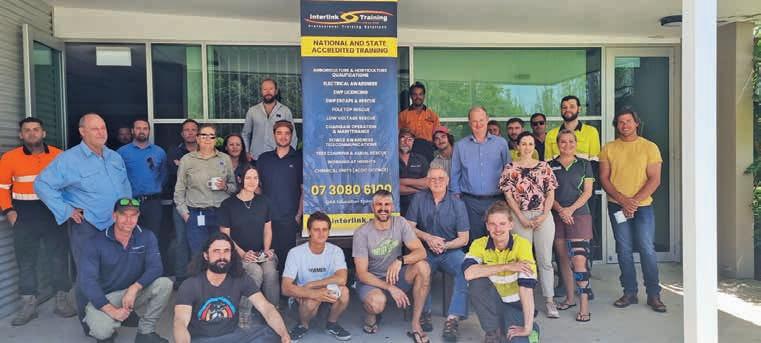
peers, and celebrate their passion for the profession. These events not only foster camaraderie within the arboriculture community, but also inspire excellence and innovation in tree-care practices.
Through ongoing education, support, and collaboration, the QAA remains steadfast in its commitment to empowering arborists and promoting excellence in arboriculture across Queensland and beyond. To find
out more and to book in to any of the upcoming events or workshops, visit the Events page on the QAA website.
QAA Executive
For info call QAA on (07) 3821 1488, email office@qaa.net.au, or visit qaa. net.au. Follow the QAA on Facebook (QueenslandArboriculturalAssociation), Instagram (qaa_arborist), or LinkedIn (queensland-arboriculturalassociation).

Elevated work platforms
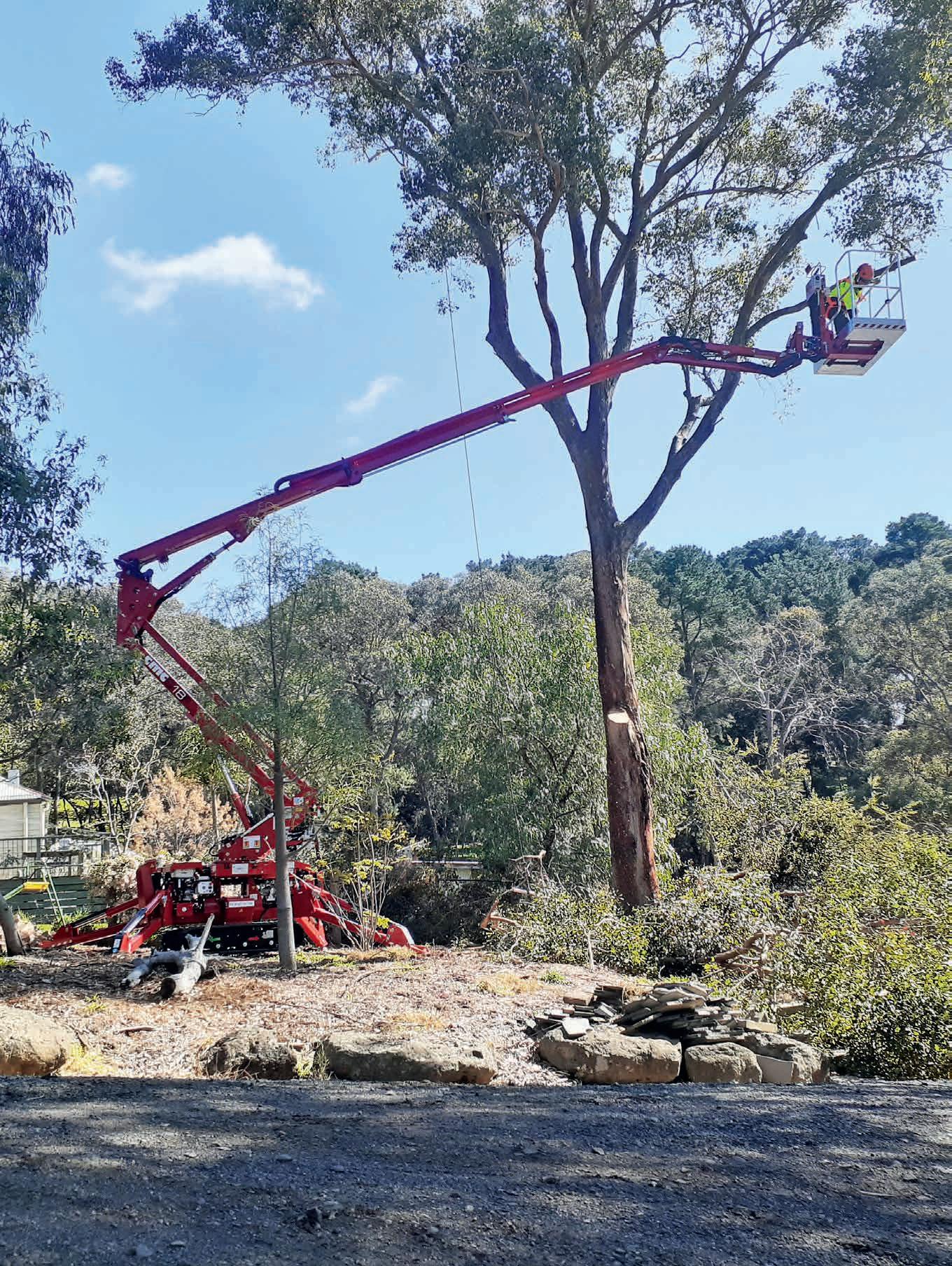
The CMC S18FR-D has an incredible 11.5m of horizontal outreach and 230kg basket capacity, combined with a 14hp Kubota diesel engine and a radio-controlled remote, to proved simple, easy operation.

With an incredible 11.15m of horizontal outreach and a 230kg basket capacity, the S18F is an ideal machine for arbor work, property maintenance, painting and more.
With a user-friendly design, the S18FR-D is towable on a 3.5T GVM trailer thanks to a weight of only 2580kg, and yet still has the ability to fit through a standard doorway, making it an ideal machine size for many industries.
Having a radio-controlled remote, auto-leveling outriggers and two-
speed drive just adds a whole new dimension for the operator, allowing them to view each side of the machine when operating and making a huge improvement in overall safety.
Also, thanks to a powerful 14HP Kubota diesel, the S18FR-D allows operating up to three functions at one time.
Monitor
To find out more about the CMC S18FR-D spider lift, the CMC range, and Monitor’s other great brands and products, log on to monitor.net.au.
• Two-speed drive
• Auto-level stabiliser legs
• Kubota diesel engine
• Remote control
• Closed LxH 5.15mx 2.28m
CMC S18FR-D specifications
• 14HP Kubota diesel engine and 240V electric motor
• Maximum working height 17.7m
• Maximum outreach 11.15m
• Basket size 1.4m x 0.7m x 1.1m
• Basket maximum load 230kg
• Turret rotation ± 178° (356° non continuous)
• Basket rotation ± 90°
• Machine weight: 2580kg
The S18FR-D is towable on a 3.5T GVM trailer “ ”

A robust and versatile trailer-mounted access platform. Images: Niftylift
210
With a 21-metre working height and 12-metre outreach, the Nifty 210 has one of the largest unrestricted working envelopes in its class.
The Nifty 210 is a robust and versatile trailer-mounted access platform with a special boom design which allows the cage to be moved vertically in a straight line using a single control, making it ideal for working near walls or buildings.
The dimensions and vast working envelope of the machine make it suited to a vast range of environments and ideally suited to the arbor industry.
A road-towable chassis and reverse overrun brakes mean the Nifty 210 can be towed from site to site by a commercial vehicle or suitable 4X4, helping reduce transportation costs and giving the user more flexibility when moving the machine.
Once the Nifty 210 is onsite, a traction-drive system operated from the cage allows effortless positioning. Hydraulically powered drums turn the road wheels and one operator can unhitch and manoeuvre from one location to another in a safe and controlled manner, even on softer ground like gravel and grass.
The Niftylift 210 comes with a versatile combination of diesel and mains power.
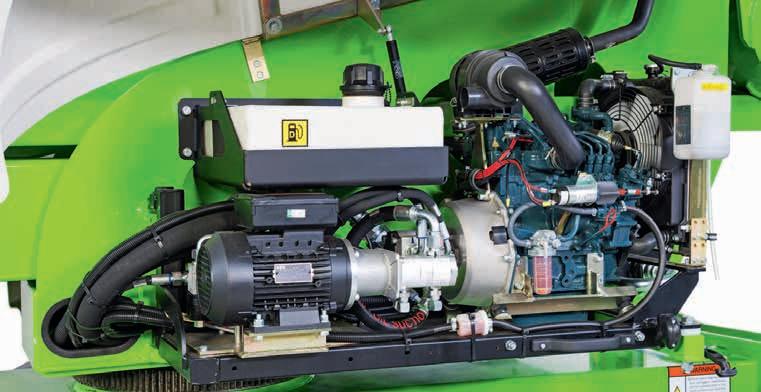
The Nifty 210 comes with a versatile combination of diesel and mains power, giving the benefits of the electric and engine power options on the same machine.
The Nifty 210’s cage will accommodate up to two people and their tools and will elevate them to a position anywhere in its class-leading, unrestricted working envelope.
Hydraulic outriggers are standard, which saves time and energy during set up. Operated from a control station in the cage, each outrigger can be controlled effortlessly for easy levelling, even on inclines or uneven surfaces. Pressure-sensitive interlocks on all outriggers ensure the machine is set up correctly and will not allow operation of the boom control until all outriggers are safely in position.
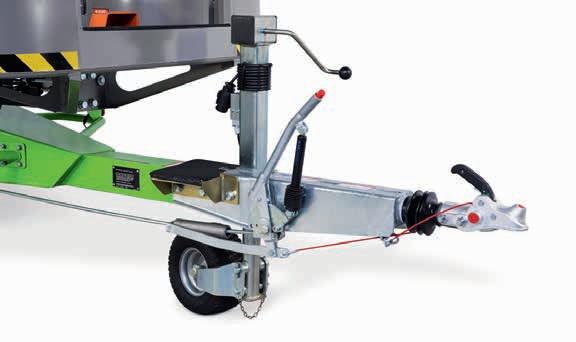

A road-towable chassis and reverse overrun brakes mean the Nifty 210 can be towed from site to site by a commercial vehicle or suitalble 4X4.
Operating the 210 is easy.
After turning on the cage control switch, simple-to-use, fully proportional hydraulic levers control all boom movements. By simply raising or lowering the levers while pressing and holding the green power button or foot pedal, the operator can easily and accurately move each boom, individually or together, to position the cage.
The Nifty 210 also features cage rotation, giving the operator precise control when positioning the cage at height.
As well as the controls in the cage there are controls at the base, providing a safety backup for the operator. In order to operate the base controls the user simply turns the key to the ‘Base’ position and then activates the levers in the same way as the cage controls.
There’s a red ‘E-stop’ next to every green power button, allowing the machine to be quickly stopped from either the base or the cage in the event of an emergency.
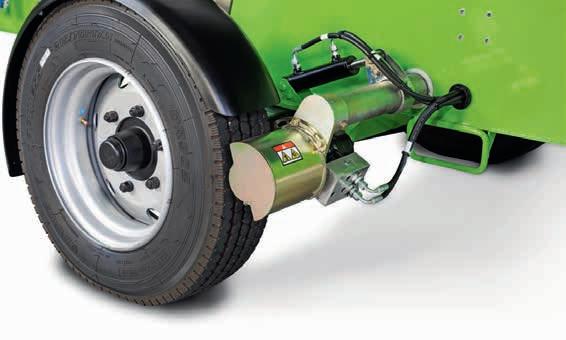

a safety backup for the operator.
A manual hand pump on the 210 allows all machine functions to be operated, even without power. Used in conjunction with the ground controls, it enables the machine to be safely lowered to the ground. The hydraulic outriggers can also be operated in this manner, so the machine can be completely stowed without any power if necessary.
Every Nifty lift incorporates check valves on all hydraulic rams to ensure that, in the unlikely event of a hose failure, the machine will remain safely in position.
With maintenance-free pins and bushes, durable hydraulic hoses and only a few easy-to-access grease points to service, maintaining the Nifty 210 is quick and simple.
The Nifty 210 fast to set up, easy to use and simple to maintain. It offers an outstanding working envelope and unrivalled low-level outreach all the way to the ground, making it ideal for working in a wide range of environments.
Quinton Garlick’s subscription to The Australian ArborAge scored him a Husqvarna 525PT5S Pole Saw valued at $1599 RRP.
Quinton Garlick is big bloke, there’s no doubt about that, and it’s fitting that one of the biggest prizes in Australian arboriculture went his way when he picked up his Husqvarna 525PT5s Pole Saw from Jason at The Red Shed in Cranbourne, Victoria. We were busting to know how the saw shaped up as part of Quinton’s arsenal at Cut It Right Tree Service.
“To tell you truth, I haven’t used it yet,” chortled The Big Fella.

When he won a chainsaw at the Victorian Tree Climbing Championship some years ago, Quinton was so rapt he wanted to gold-dip the bar and just keep it in pride of place.
“But I never did it, did I?” he laughed. “The Husqvarna will probably sit there on the trophy shelf for a little while, but then I’ll grab it and get to work.”
What a dead-set champion, and a deserving winner. You could be next winner we speak to!











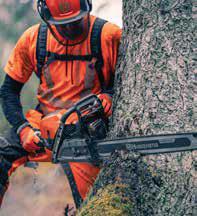










Arborist and forestry jobs are incredibly tough on people and tough on tools. But STIHL has a few key accessories to help make your working lives easier.
Whether it’s simpler chainsaw maintenance, quicker cutting time or clearer communication with your team, these genuine STIHL accessories are must-haves for forestry professionals.
Want to give your forestry chainsaw a new lease of life? Then look no further than STIHL’s Hexa upgrade kits or new Hexa chain loops and file.
The new STIHL Hexa chain has a hexagonal (instead of round) cutting shape and gives 10 per cent faster cutting performance and simpler sharpening. And because the angle of the cutter is less acute, it holds its edge for longer too.
Hexa chain loops can be bought separately, but the kits with the file and two Hexa chains are better value than buying all the items separately.
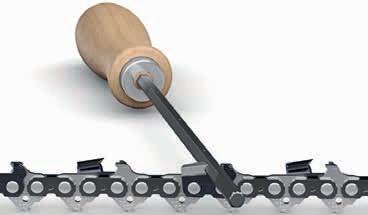
STIHL ADVANCE ProCOM, the company’s smartest hearing to date, connects up to 16 users across vast distances with market-leading technology that makes communication simple. Simply turn the ProCOM headsets on and they automatically connect together. Each headset can then be up to 600m apart, as they each operate as a signal repeater. STIHL ProCOM headsets can connect to another device, such as a phone or walkie talkie, via Bluetooth
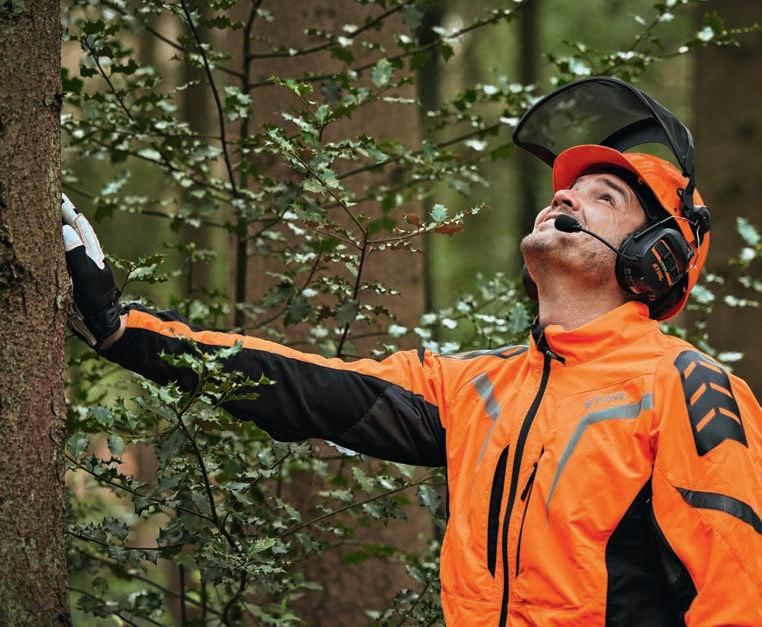
and have a built-in ambient mode. Just turn ambient mode on and you can hear the outside world as if you didn’t have ear defenders on. When a chainsaw revs up nearby, they then automatically stop playing the sounds from the outside world into your ears, except your colleague’s voices from other ProCOM sets, so you can communicate without interruption knowing your ears are properly protected too.
Simple but effective, STIHL’s handy stump vice is ideal to help sharpen your chainsaw chain in the forest or on a job. Simply tap the vice into a stump and secure the bar in it. It will hold the chainsaw bar firm so you can sharpen the chain without the chainsaw moving around.

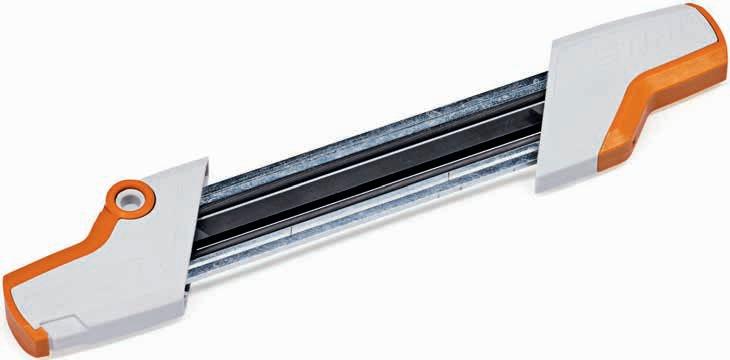
Why not make sharpening your chainsaw chain on the job, or back at the workshop, even simpler?
While more experienced chainsaw users may prefer to use a manual file and depth gauge, STIHL’s 2-in-1 file sharpens the cutting tooth and files down the depth gauge at the same time, shortening sharpening times and making sure it is filed to the correct 30-degree angles for the standard chainsaw chain.
It’s really handy if you hit something in the wood, touch the ground or just need to sharpen the chain up quickly.
After all, a sharp chain makes for more efficient cutting, improving battery longevity or fuel economy.

STIHL’s
The STIHL Light 04, .325”, 1.3mm lightweight guide bar features a special, slim design that enhances piercing characteristics and reduces weight. This makes demanding work more comfortable and enables greater endurance during sawing. The STIHL Light 04, .325”, 1.3mm is 200gm lighter than the existing STIHL guide bars, contributing to an improved system weight.
The innovative design of the STIHL Light 04 guide bar is not only attractive but also integrates practical information about the bar’s characteristics – making finding the right saw chain for the chainsaw bar easy, for example.

STIHL make a whole host of great tools to make lifting and dragging timber much simpler.
Moving timber can be one of the toughest parts of the job, so tools like STIHL’s hand lifting tongs are a great option! They grab the timber so you just have to focus on pulling up, rather than grappling with the log and getting underneath it.
The STIHL drag hook does exactly what it sounds like it should – simply hook the sharp end into the timber and you can manoeuvre or drag it to where it needs to be.
Keeping on top of maintenance of a tool fleet can be much simpler with STIHL Connected.
This fleet-management system logs hours on the tool so it lets you know when maintenance is due. It can even be used on non-STIHL tools where you simply add in a service schedule you want to stick to. It’s really simple to set up, helps keep an eye on your entire fleet in a matter of seconds, tells you when tools are in and out of service, allows you to book a service with your nearest or preferred dealer and keeps a full record of all your fleet maintenance.


HTwo new ZAXIS-7 compact excavators from Hitachi are designed to enhance productivity.
itachi Construction Machinery (Australia) Pty Ltd (HCA) has unveiled two new ZAXIS-7 compact excavators designed to enhance productivity in contemporary urban construction sites.
The ZX75US-7 boasts an ultra-short tail swing radius, enabling easy access to tight spaces, while the ZX85USB-7, equipped with a swing boom, efficiently excavates near walls and guard rails.
The power for these machines is derived from the reliable Yanmar diesel engines equipped with proven turbocharging technology. This environmentally friendly engine meets EPA final Tier 4/EU Stage V emissions standards, with diesel particulate filter, EGR and common rail to help further reduce emissions. The machines also feature a versatile power/ economy work mode that adapts the machine’s performance to the specific task at hand. In power mode, the engine operates at higher speeds to deliver additional horsepower when necessary, whereas the economy mode optimises fuel efficiency by reducing engine speed during regular operations. Furthermore, both machines are equipped with a builtin auto-idle system, which automatically reduces the engine to an idling speed if all control levers remain in a neutral position for more than four seconds. Once the levers are reactivated, the engine quickly returns to the previously chosen speed. This feature not only helps in reducing noise and exhaust emissions but also plays a pivotal role in energy conservation and cost savings for operations.

Contractors and sub-contractors take care of their own insurance – as opposed to the business owner having to provide coverage for them, as is the case with employees. But what if things aren’t quite that straightforward?
Insurers do not include subcontractors under liability insurance policies. If they did this, the insurer then accepts the liability for all of the work the subcontractor undertakes.
The subcontractor could potentially cause an incident which results in property damage or an injury to a member of the public, and the subsequent insurance claim would be held against you, because they are an insured party under your policy.
Imagine subcontracting a treelopper who damages the roof of a house while removing the tree. What was a $1000 job results in $100,000 in damage.
It’s crucial for small businesses to ensure all contractors and sub-contractors have appropriate Contractors’ Insurance in place.
Check the paperwork
What policy?
That depends on the job, but a humble suburban tradesman will often have public and products liability, professional indemnity and workers’ compensation insurance.
The best way to ensure a subcontractor has their own cover in place is to obtain a Certificate of Currency from them. It will provide the information on their policy and can give you re-assurance they have cover relevant to the work you’re proposing.
Your liability policy should also include an extension for Vicarious Liability.
Vicarious Liabilities can arise in situations where you are responsible for a third party (eg: the subcontractor or contractor working for you), and they are negligent in carrying out that responsibility and exercising control. If they are negligent, you may be deemed to be responsible for some of the property damage or bodily injury caused by the subcontractor or contractor. Vicarious Liability covers this exposure for you, so it is important to check your policy includes this extension.
Some key points to remember when dealing with subcontractors:
• Ensure all contractors are aware of their responsibilities and understand house rules
• Ensure records are kept up to date detailing contractors’ attendance at principal’s induction program
• Confirm all subcontractors or contractors have their own adequate insurance cover that provides indemnity for you by naming you as their contract principal
• Check the cover a subcontractor has in place includes sums insured that match your insurance cover and has no clauses that will pass the liability on to you, or exclusions that relate to the work you are performing, and
• Obtain and keep on file a copy of each subcontractor’s Certificate of Currency and diarise to ensure an updated certificate is obtained each year or for when new work is performed.
Contractors who come on board and purchase a machine can lock in their working areas exclusively and be rewarded for their early take up on this worldwide patented machinery. This will allow you to secure an hourly rate and be able to maintain a profitable and sustainable business without competitors undercutting in your area. Areas are going fast and have already been finalised in Adelaide, Geelong, Warrnambool, and Southeast Melbourne.
Foamstream is the leading herbicidefree solution for controlling unwanted vegetation including weeds, moss, and algae. Its patented lowpressure process combines hot water and biodegradable foam, made from natural plant oils and sugars, making it safe for use around people, animals, and delicate environments.
With our lance sets, it can also be used for chewing-gum removal, pressure washing and general sanitation jobs, making it a highly effective, all-round, green-space and urban-management system.
Committed to ensuring we deliver the safest, most environmentally friendly products we can to our customers, Foamstream foams have been cleared for use as an organic, non-toxic, safe product by the following bodies:
• Australian Pesticides and Veterinary Medicines Authority
• ACO (Australian Certified Organic)
• US EPA
• Health Canada
• REACH UK, and
• Biogrow NZ
The active ingredient in the process is the heat in the hot water. The foam simply acts as an insulating blanket over the top of the hot water, ensuring heat is not lost to the atmosphere.
Using our industry-leading machinery, Foamstream is applied to vegetation at low-pressure and can be used in all weathers. Once it hits the vegetation and covers it, the foam creates a thermal blanket over the vegetation and the water.

Foamstream provides the most effective way of killing vegetation, meaning fewer treatment cycles are needed per year compared to any other alternative thermal method of weed control. By needing fewer treatment cycles, less labour is required over the course of the year, reducing overhead costs for customers.
In addition to killing the plant, Foamstream also sterilises surrounding seeds and spores that haven’t yet
Foamstream is a highly effective, all-round, green-space and urban-management system. Images: Weedingtech
germinated, helping reduce future weed growth.
By combining the most effective method, the fewest treatment cycles per year and the ability to sterilise seeds and spores, Foamstream offers customers the lowest cost of ownership and operation cost in the alternative herbicide-free space. As Foamstream can also be used for so much more than just weed control, the commercial case for using Foamstream over alternatives becomes highly attractive.
The leading herbicidefree solution for controlling unwanted vegetation. “ ”
Who is
Foamstream is ideal for any company, contractor, council, or organisation looking to reduce the use of herbicide from their practices and replace it with the most effective and efficient alternative. It is also for any organisation that needs to carry out a wide range of jobs to manage green and urban spaces, including management of artificial surfaces.
It can be used safely in public spaces, on utility sites, or in any space which requires an eco-friendly method of treatment, and poses no threat to people, animals, the environment, or the operator.
To find out more about Foamstream, call 1300 866 911, or log on to weedingtechaustralia.com.au.

With a lance set, Foamstream can also be used for chewing-gum removal, pressure washing and general sanitation jobs.



The Vermeer SC48TX Stump Grinder offers the latest in stumpgrinding technology and is specifically designed to help contractors systematically cut stumps of all sizes. Images: Vermeer Australia
Site preparation is the often-overlooked first stage in the construction process, and site clearing and stump removal is a key part of that.
Before construction can kick off, necessary site preparation – such as stump grinding – may need to be carried out. With such a wide variety of types and sizes of stumps often needing to be removed, contractors are looking for new, bigger and better equipment to help them get the job done. No two jobs, stumps or sites are the same, but having a range of stump grinding machines to cater to each situation is costly – not to mention time wasted to swap out machines. Powerful, flexible, adaptable equipment which doesn’t sacrifice efficiency and
productivity is essential for industry professionals.
With its new SC48TX Stump Grinder, Vermeer Australia understands this challenge and rises to the occasion.
The SC48TX Stump Grinder offers the latest in stump-grinding technology and is specifically designed to help contractors systematically cut stumps of all sizes. The 48hp (36kW) diesel engine gives optimal fuel economy, durability and performance, and the
beltless direct-drive system delivers maximum power from the engine to the cutter wheel through a pair of gearboxes connected by a driveshaft.
The beltless design of this system also means contractors can expect minimal maintenance costs.
The machine’s low ground pressure and narrow footprint gives operators access to previously unattainable locations. Challenging and narrow job sites are no longer an issue as the SC48TX allows users to retract the machine to only 35 inches (89cm) and then extend the tracks to 49 inches (124.5 cm).
The low-disturbance tracks provide optimal traction and stability in tough, uneven ground conditions, reducing the time needed for job prep, and the blade’s rounded lower edge leads to minimal turf damage.
The optional backfill blade efficiently moves chips around the jobsite, eliminating the requirement to manually relocate the chips and mitigating the need for a lengthy cleanup.
The unique Vermeer cutting system boasts a two-sided cutter wheel which minimises recirculation of material and maximises cutting performance, enhancing jobsite productivity and streamlining performance.
Jobsite flexibility, safety and visibility is further enhanced with the SC48TX’s optional full-function remote control – meaning equipment can be operated without the need for an operator physically standing at the operator’s station.
Vermeer Australia prides itself on providing innovative machines equipped with smart technology and the SC48TX Stump Grinder is no exception, fitted out with the Vermeer cutting system, SmartSweep™ control system, and the operator presence system. The multifunctional display (MFD) goes the extra mile for operators, displaying hours, fuel level, engine speed, engine faults and engine status.
Contractors can rest easy knowing the machine’s CAT engine is backed by proven worldwide service and support and comes with three-year coverage.
Further adding to user confidence, Vermeer offers extended service coverage, preventive maintenance and the Vermeer Confidence Plus® asset protection program.
More than just offering the latest high-quality, high-performance and functional equipment, Vermeer Australia provides after-sales support and service, with a team of industry professionals on hand across 10 branches to assist customers.
For more information on Vermeer products and services, call your local Vermeer Australia team on 1300 VERMEER or visit vermeeraustralia.com.au

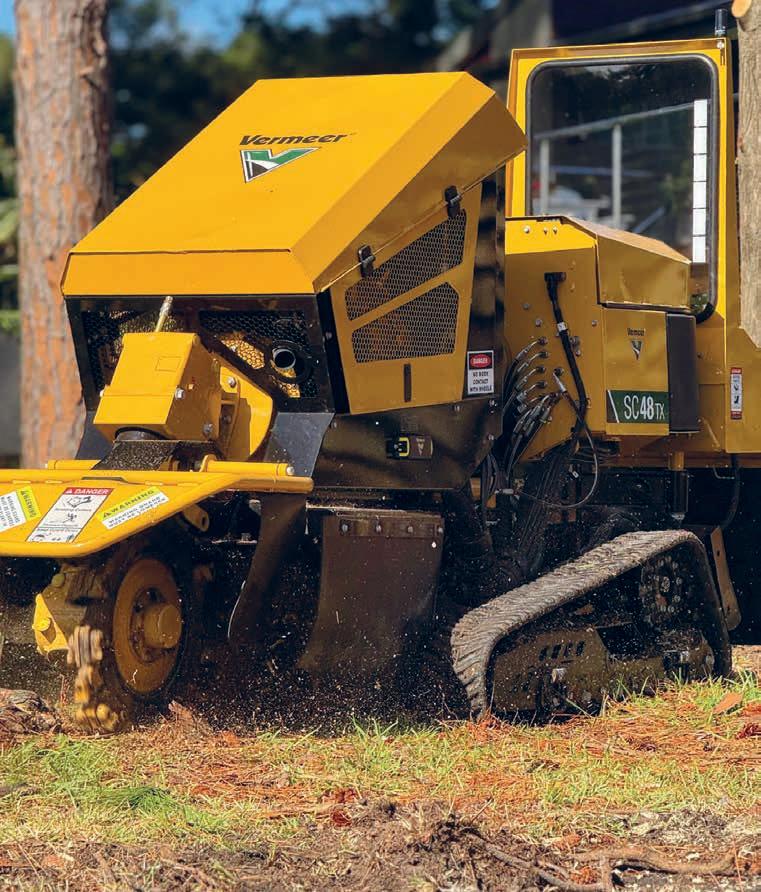

The finished product: a custom designed and built chipper bin, with crane and toolboxes, which doesn’t exceed the truck’s GVM or weight capabilities.
Images: Shakanda
Designing and fitting out trucks and work vehicles is an exacting and technically involved process. ‘Process’ is a big part of every Shakanda custom build.
Victorian-based truck-body builder, Shakanda, specialises in custom designing and building just about anything for any truck or working vehicle, but its Chipper Tippers are a much sought after item. The company claims it produces ‘…the finest quality Chipper Tipper bodies for all parts of the country’, featuring a three-year structural warranty, a fully sandblasted, 2-pack, zinc-primed and 2-pack topcoated finish, and a stack of optional extras.
A Shakanda catchcry is, “Our Chipper Tippers are made to last!”
The Australian Arbor Age covered the hardware and build side of the Shakanda Chipper Tipper in the February/March issue, but the more we looked at it, the more we wondered at what must be involved in ensuring a true custom build meets the customer’s expectation.
Shakanda’s Body Building Manager and Head of Engineering, Tim Knight, talked us through it.
“A customer will come to us and say which make or model of truck they have, and what features they’d like the final build to have,” Tim explained. “Once we have that clear we will complete a 2D
(two-dimensional) layout drawing.
“It’s a preliminary drawing, which has weight calculations and estimations, and it gives the customer the chance to look at the actual truck and what they’re having fitted to it. The drawing tells them what their payload is going to be and gives an estimation of front-axle and rear-axle weights on the fully loaded vehicle. This ensures they get the capacity they need without exceeding any regulatory limits.
“This is accompanied by a quote based off the 2D drawing, and usually has a list of other optional items that could be added to their build.”
“That’s the first stage.”
Once the customer has had time to check through the drawing and ensure everything is as they imagined and requested, and the quote is accepted, the next step is for Shakanda to schedule the build into its system, then engineering starts modelling up the specs using Solidworks. This is when the 3D (threedimensional) Model is created. From the 3D model all the work instructions and drawings for the build are done so the vehicle body can be manufactured.
Tim continued…
“The 3D modelling is based off the 2D initial drawing, and it’s for fabrication, but we also get the customer involved at this stage.
“Even though they’ve signed off on their two-dimensional drawing, it’s always better to have a look at a threedimensional model. It’s more intuitive for a customer if they can visualise the whole vehicle and its features in 3D. The customer can see and look over their vehicle. If the customer can’t meet in person, we can do this over Teams, Zoom, Google Meet or something like that, and wherever they are – on their phone, tablet, in their office, wherever –they can see the model.

“We share the model live. We go over all aspects of the build and show them everything. At this stage the customer might decide to make changes or may be happy with our design and we will move to the next stage.”
The precision and procedure used in planning a Shakanda job is a reflection of the care and attention to detail which goes into the build itself. Ensuring the customer’s vision is being made reality is at the heart of custom work, and
ensuring the safety and durability of the work itself is at the heart of Shakanda’s philosophy.
As Tim pointed out, “You could pick any make and model you could possibly want. We can custom design a chipper bin, or pretty much anything a customer needs, and make sure it has the maximum payload possible without exceeding the truck’s GVM or axle capacities. We give as many estimations and as much information as we can to the customer so they can make informed decisions.”
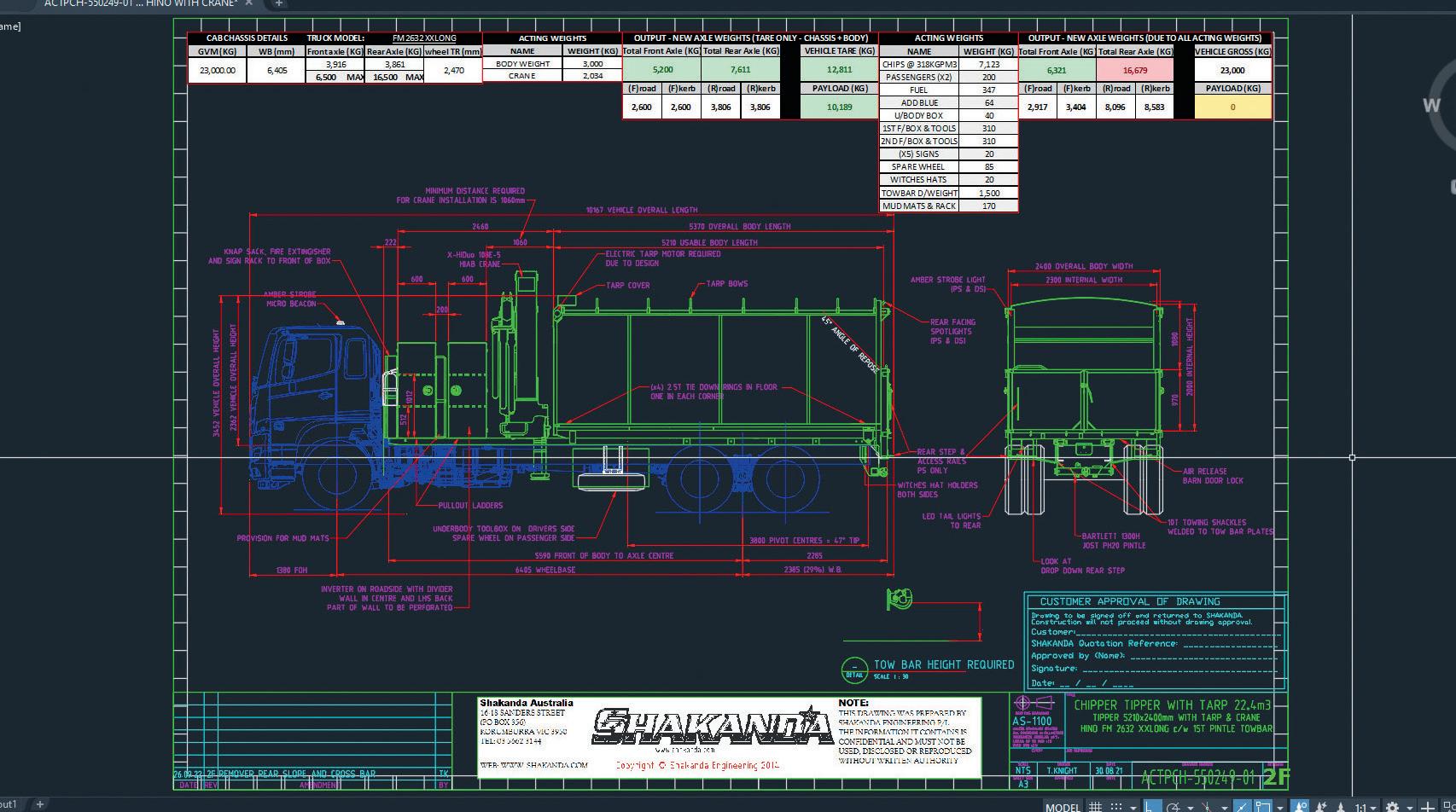

With its two knuckles the crane can be folded into a smaller size, but can also extend to reach loads at a distance.
When it comes to tree work, having the right equipment can make all the difference. Among the various types of cranes available for arboriculture, the knuckle boom crane stands out as a versatile and efficient choice for emergency tree removal, storm-damage tree removal, general tree removal and other related tasks.
Canopy Lift’s Hiab X-Hipro 638 crane, especially when paired with the company’s Mecanil SG220 remote rotating grapple saw, is a reliable option available for hire across New South Wales and interstate.
Knuckle boom cranes – also known as Kbooms, loader cranes, articulating cranes, or picker cranes – have revolutionised loading and unloading across a wide range of industries, thanks
to innovative engineering.
Unlike a straight boom crane, a knuckle boom crane has a knuckle above the pivot point, one main boom and a jib on the end of the main boom. It works in a similar fashion to a human index finger. With its two knuckles the crane can be folded into a smaller size, but can also extend to reach loads at a distance, versatility denied to straight boom cranes. This gives the operator the ability to reach down and under, while also allowing attachments, such
as grapples and clam-shell buckets which operate via the crane’s hydraulic system, to be manoeuvred and operated in positions and situations a straight boom crane simply can’t.
Canopy Lift’s 638 Hiab x Hipro crane is compact, has a big reach, and is available for hire across Australia. Built for all conditions, the 638 can handle rough terrain and make light work of even the most restricted setup

Maximum crane height with manual extension is 29m, and horizontal reach is 26m with manual extension.
areas. The truck footprint once set up is 8.1m long and 7m wide and can be shortened for tight access. The maximum crane height with manual extension is 29m, and horizontal reach is 26m with manual extension. The crane can lift a ton at those limits.
Canopy Lift’s crane is 24/7 to handle emergency tree removal and stormdamage tree removal – like trees on houses – ensuring quick and efficient solutions when they’re needed most. Canopy Lift is a fully insured, licenced and professional business which adheres to all current codes of practice and offers very competitive prices, and the crane is inspected annually through Hiab partners and goes through crane safe certification every year.
To find out more, call 0458 401 601 or log on to canopylift.com.au.
Canopy Lift offers more than just tree-work crane hire. The Hiab X-Hipro 638 crane is available with a range of attachments, including:
• A three-ton winch
• Multiple chains and straps, either from the winch or dedicated hook
• Spreader bar
• 10-ton crane scales
• Mecanil SG220 remote rotating grapple saw, and
• 450L rotating clam shell bucket.
All rigging gear is inspected and tagged by IWR Rigging on a threemonthly basis.

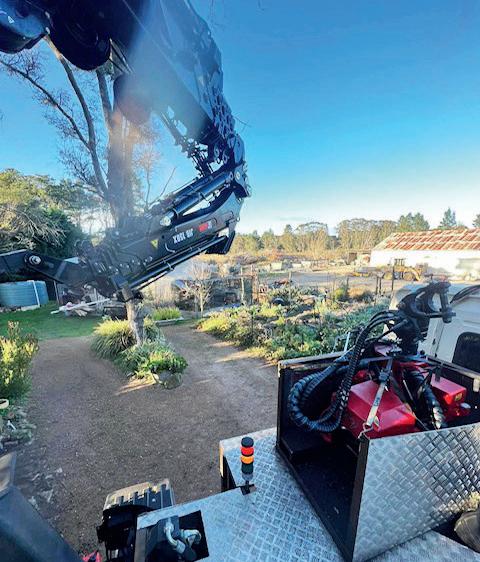
Fig 1: Trees and turf: a classically soil-compacted horticultural environment – a kick in the guts of the tree. The rhizosphere or soil/root interface (the plant-stomach-lining) is the place where the tree meets soil-life and exchanges plant sugars for nutrients.

For most of us ‘organic’ has become more of a human buzzword than a descriptor for nature and natural process. Correctly used, the word relates to the nutrient-cycle and the passage of inorganic elements, as nutrients harvested from the atmosphere, that move or get synthesised into the bodies of plants, thus making those elements organic (a bio-element), and available to us.
Plants are at the forefront of the
nutrient-cycle which supports all bodies. Though there are numerous nutrient cycles, carbon – the building block of physicality, transitioned from inorganic to organic by photosynthesis – is the most obvious one.
Plants link the atmosphere and the rhizosphere via their bodies. As Shigo told us, they are the living pumps – the generators that move life on earth. All they need to live long is light sufficient to their species, air, water, and bioactive-
carbon. When we take away or tamper with any of those foundation needs, we literally kick them in the guts. When it comes to nutrient absorption, the rhizosphere, and our stomach lining, we share parallels. To support trees the way nature intended we need aerated soils, nutrient beds and plant systems to the dripline as a minimum. This protects and nurtures the structural root zone and the tree protection zone in ways arboriculturists fantasise about.



Fig 4 (above): Whereas young trees may endure the highly bacterial turf environment in the short term, in the long term, trees live short lifespans because of fungi deficient soils and a lack of mycorrhizae. Fig 5 (below): Roundabouts surrounded by bitumen and the development process are usually highly biologically-desertified. Perennial plant associates – and the microbiology that accompanies them – make all the difference for trees. In rare cases below-ground resources (ie: old creek systems – Ficus and Creek Street in Brisbane City, spring to mind) are accidentally sustained during development, resources that retain air, compost and water below bituminised surfaces. This demonstrates what can be achieved in association with the engineers at planning stage with New Earth ventures in mind.


Available to demo and buy! With a 42” diameter x 63” wide cuttermill, this horizontal grinder can handle all types of wood, plastic and more. Ready to freight Australia wide, enquire today!


Tree Radar Australia uses a ground penetrating Radar Unit to provide the only, completely non-invasive method of tree decay detection and tree root detection available in Australia.
TREE RADAR UNIT™ DECAY DETECTION.
Tree Decay is a severe problem which can put all the structure around a tree at risk. With Tree Radar Units™ decay detection, Tree Radar can scan for decay in any tree regardless of its height.
The Tree Radar unit can give an accurate read out of the severity of decay in a tree without having to penetrate the Tree’s surface.
TREE RADAR UNIT™ TREE ROOT DETECTION.
Tree Radar Unit™ can detect and establish the root proliferation of a tree, this allows the arborist to inform developers of any structural or instability issues without the need for drilling or digging.

Fig 6 (above): A traffic island I restored from desertification to a de-compacted, species-diverse understory. The full restoration process features in the Heart of Arboriculture in AAA Oct/Nov 2021. Fig 7 (below): The rainforest remnant at Mary Cairn-cross Scenic Reserve in Queensland is an interesting study relating to the nutrient cycle. The floor of this forest is kept clear of leaf litter by the Giant Earthworm (1m-3m long, 2cm-3cm thick). A number of species are found throughout Australia’s hinterland ranges, and these remarkable creatures clear the whole forest floor of leaf litter and small twigs, dragging the shed organic matter into their tunnels. The important impact this organism has is in the multiple tunnels it creates. Earthworms generally deposit their castings above ground, but not so the Giant Earthworm. It deposits its castings below ground. The Trapdoor spider, freshwater crayfish, and a host of other organisms help keep rainforest soils friable via their tunnels. Barring organisms displaced by us, there are few natural organisms that are counter-arboriculture – except modern humans (particularly engineers).


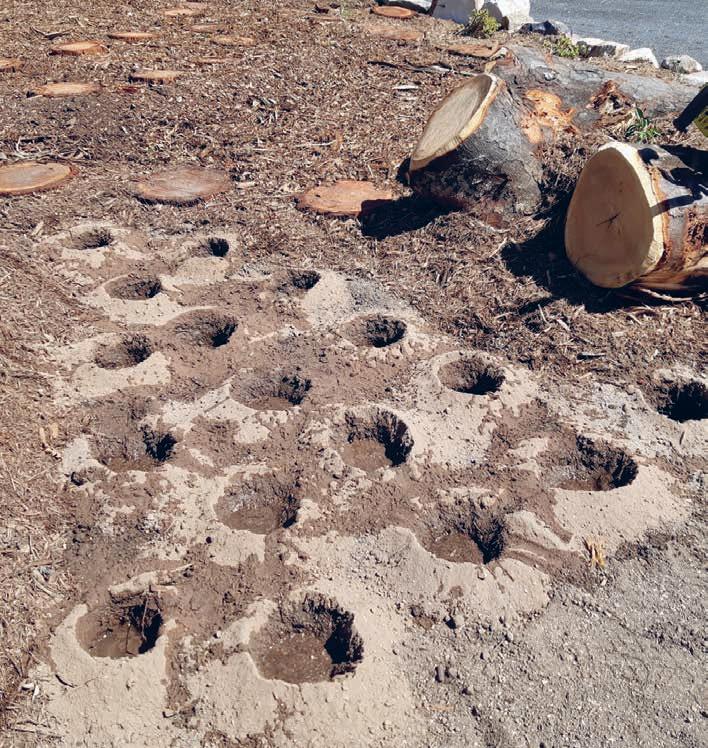




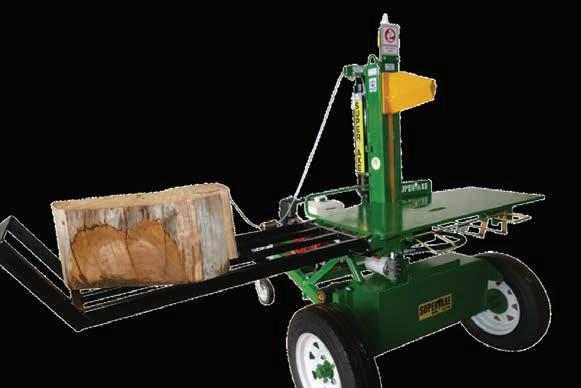
 Fig 8 (above): We can see the fluffy soil deposited at the site of this excavation. Whether created by a Giant Earthworm, Funnelweb spider, or freshwater crayfish, the fissures help keep the soil friable.
Fig 10 (above): The microbiology associated with the forest is integral to the nutrient cycle that processes timber into humus. Fungi are as essential for processing wood (lignin and cellulose) as they are in supporting woody plants to absorb nutrients from the rhizosphere. In live trees the fungi enable solid trunks to lose static ballast by decaying heartwood, The fungi and the decay process – involving brown rot, soft rot and white-rot wood decay – are intrinsic to nature and the ecosystem.
Fig 8 (above): We can see the fluffy soil deposited at the site of this excavation. Whether created by a Giant Earthworm, Funnelweb spider, or freshwater crayfish, the fissures help keep the soil friable.
Fig 10 (above): The microbiology associated with the forest is integral to the nutrient cycle that processes timber into humus. Fungi are as essential for processing wood (lignin and cellulose) as they are in supporting woody plants to absorb nutrients from the rhizosphere. In live trees the fungi enable solid trunks to lose static ballast by decaying heartwood, The fungi and the decay process – involving brown rot, soft rot and white-rot wood decay – are intrinsic to nature and the ecosystem.


Fig 11 (above left): This brown-rot decayed log with its cellulose long gone has become an above-ground resource for the occupation of feeder roots from neighbouring live Tallowwood gum trees. The log, now looking more like charcoal (natures bio-char) than timber, provides a network of oxygenated galleries for the essential associate microbiology and feeder roots. I have seen the same plant-root occupancy with white-rot galleries in standing trees and cut palm logs where the above-ground log becomes an extension of the rhizosphere.
Fig 12 (above right): Ripped logs, cut longitudinally – with the grain – make the best interface between treated soils and turf. The raw, ripped, hardwood logs last a few years before becoming compost. These are easy to process, easy to install (they become glued to the soil by Glomalin) and easy to replace.
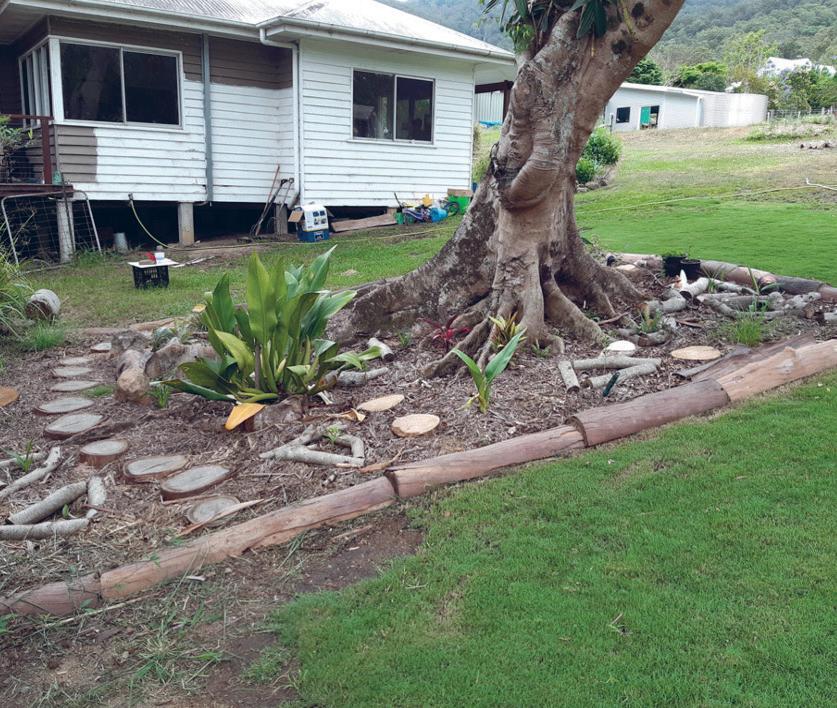
Fig 13 (above): The Poinciana’s structural root zone was a major thoroughfare, so I installed a ripped timber perimeter, a log-round pathway (and pond for the children), as well as vertically treated the area, including tilling the compacted soil surface. I planted an understorey of native tube-stock to achieve nutrient-bed vegetive closure, adding to reduced temperature control.

Fig 14: The traffic-island project nutrient bed,16.5m by 9.5m, roughly 155m2, was treated with approximately 910 fissures to de-compact and open up pathways for microbiological activity. Fissures ranged from 10cm diameter (done with an auger) to tube-stock size, with 290 young plants in the ground, capped with composted forest-blend mulch, log rounds (to act as maintenance pathways to prevent future compaction) and ripped-timber edging to interface with turf on the western side.

Herbicide Free weed control using hot water and foam not steam
Secure your area / no franchise fees
Purchase a machine from $288.00 per week
Herbicide Free Weed Control
Pressure Washing / House Washing & Factory Washing
Sanitisation


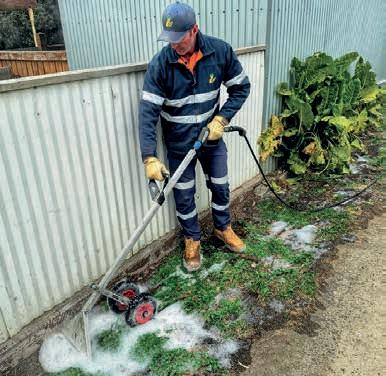

1300 866 911 for more information. by

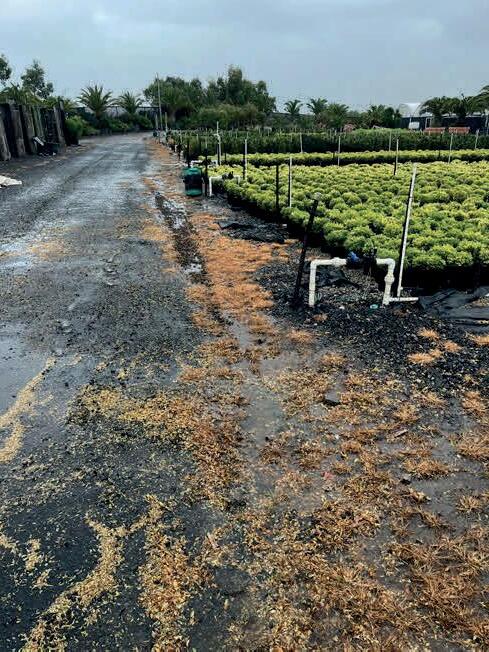

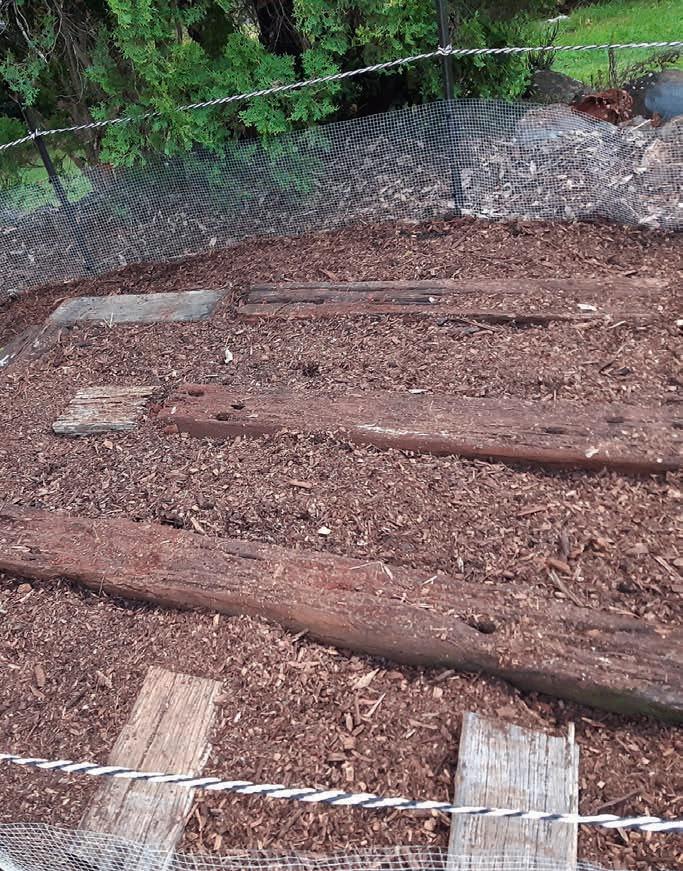

vegetable gardens, creating fissures, trenches, or simply single digging:
(10 per cent), depending on resource availability. In the case of this salad/vegetable garden I treated with fissures under the sleeper pathways to support root generation under the paths. This maximised surface area/water retention, I utilised 1.5m of compost that I harvested straight off an old tree and leaf-litter-covered horse shed.
I make reference to compost it is always cold-processed, nature’s way, not the human, heat-treated bacterial
compost. Here’s a good three cubic metres of nature’s chocolate-gold I harvested off the barn and incorporated into the vegetable garden.
The backbone of this article is a rerun, far less the original chunk of science and references, but equally solid on the reason.
At the time I wrote the original I admit I was a bit pumped up with the story that followed on from Covid time, so there may have been some of my story caught up in that narrative. Still, as a piece, it was, and is, useful to highlight the reason why we arboriculturists need to be creating cold-processed, top-end mulches and composts.
I encourage you to re-read Land Care via Vegetation Management Part 1 in the June/July 2022 issue of The Australian Arbor Age. Part 2 was an introduction to the concept of Naturaculture and was Prime Creative Media’s first article from me: Soldiery, Adventure Riding and Arboriculture in the December/January 2023 issue.
Those past narratives explored my prediction that it will be our profession which will have the opportunity to unite the allied land-management stakeholders because of the need for bio-active carbon resources – a compost product range I believe we should be responsible for producing and making money from – as well as developing the microbiological mind behind the service, something that can only broaden our integrity as arboriculturists. I likewise consider we are being naive as tree- or land-care professionals if we think we can sustain our families into the future by clearing vegetation into cooked stockpiles that do nothing to restore soil health or support the natural cycle of biology. There will come a time when land clearing will be a thing of the past, especially if we help write the future. I solemnly pray that mainstream arboricultural education takes on
the Naturacultural or conservation arboriculture principles I live by.
My next evolutionary step is to return to Britain for my first book launch and to partner with a historic estate to co-create my first Conservation Arboretum, and to co-fund such a venture via delivering Naturaculture-based education. In time I will be looking to achieve the same Downunder, hopefully in Canberra.
Time will tell.
In closing, whether we create counterarboriculture, non-sustainable treeculture, or we create conservationarboriculture, we are still working with the same elemental resources of air, water, and carbon. We are still using manpower and a measure of machinery, though in the latter model I suggest we are working far more intelligently.


WE UNDERSTOOD THE INDUSTRY CHALLENGE, AND ROSE TO THE OCCASION.
Vermeer’s new SC48TX Stump Grinder offers the latest in stump grinding technology and is specifically designed to help contractors systematically cut stumps of all sizes. The 48 hp (36-kW) diesel engine enables optimal fuel economy, durability and performance, while the beltless direct-drive system delivers maximum power from the engine to the cutter wheel through a pair of gearboxes connected by a driveshaft – and the beltless design of this system means contractors can expect minimal maintenance costs. Contact your local tree care specialists at Vermeer Australia today.

